
| Please Sign the Guestbook | You can read previous entries by clicking here | Archived "Latest News" | back to the KOS Homepage |


Updated 31st. December 2003.
31/12/03 The last
few days of the year provided us with a welcome period of settled weather,
mainly dry with clear blue skies and sub-zero temperatures at night, down to
-6.6ºC in the early hours of the 30th.
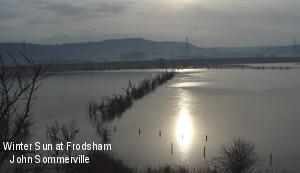 We
enjoyed the annual Christmas walk round Budworth on Monday (29th.), finishing
as usual at the "Red Lion", opposite the church in the center of the
village, where we found the Greenalls bitter on good form and the steak &
ale pie still excellent value. Nothing of great interest on the way round,
although since our last visit 3 days ago the Herons had returned in large
numbers to the Heronry at Budworth Mere, there were 40 birds perched amongst
last years nests; staking their claims for the coming season. The following day
we journeyed across to Frodsham Marshes, very cold again but good viewing
conditions. The Weaver Bend held little in the way of wildfowl, just small
numbers of Mallard, Tufted Ducks, Teal, Goldeneye and a single Drake Pintail,
but on the fields overlooking the river a nice flock of Plovers were feeding,
Jill counted 350 Golden Plovers mixing with an equal number of Lapwings - a
fine sight with the sun behind us and the birds on white frosted grass against
a background of the Mersey Estuary. Further round we took a short walk across
one of the old tanks, putting up 4 Grey Partridge and discovering a substantial
flock of finches feeding on the seed-heads of Lesser Burdock, Teasel and
Ragwort - around 300 birds, mostly Goldfinches, about 40 Greenfinches and a
lone Chaffinch.
We
enjoyed the annual Christmas walk round Budworth on Monday (29th.), finishing
as usual at the "Red Lion", opposite the church in the center of the
village, where we found the Greenalls bitter on good form and the steak &
ale pie still excellent value. Nothing of great interest on the way round,
although since our last visit 3 days ago the Herons had returned in large
numbers to the Heronry at Budworth Mere, there were 40 birds perched amongst
last years nests; staking their claims for the coming season. The following day
we journeyed across to Frodsham Marshes, very cold again but good viewing
conditions. The Weaver Bend held little in the way of wildfowl, just small
numbers of Mallard, Tufted Ducks, Teal, Goldeneye and a single Drake Pintail,
but on the fields overlooking the river a nice flock of Plovers were feeding,
Jill counted 350 Golden Plovers mixing with an equal number of Lapwings - a
fine sight with the sun behind us and the birds on white frosted grass against
a background of the Mersey Estuary. Further round we took a short walk across
one of the old tanks, putting up 4 Grey Partridge and discovering a substantial
flock of finches feeding on the seed-heads of Lesser Burdock, Teasel and
Ragwort - around 300 birds, mostly Goldfinches, about 40 Greenfinches and a
lone Chaffinch.
26/12/03 Along with most other members,
this week I received my renewal payment information and cards for next years
RSPB membership, on the back was an interesting map of the Societies reserves.
In a rough square, with corners at the Marshside, Symonds Yat, Ouse Washes and
Blacktoft Sands Reserves - a huge area, covering more than 6000 square miles
there are only 2 Reserves - Coombes Valley and Sandwell Valley. Compare this
with the Norfolk and Suffolk coastal strip with 9 and the Orkney Islands where
they
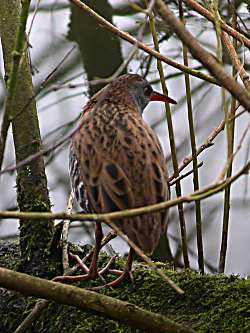 have no
less than 13 - more than enough for all the nesting seabirds, Peregrines,
haggis and bagpipes in the whole of Europe! The cities of Manchester,
Sheffield, Derby, Nottingham, Wolverhampton and Birmingham all lie within this
area, so as a percentage of population we don't do very well. Parts of Frodsham
Marshes, many areas of Pennine moorland and any of the newly excavated Cheshire
sand quarries would make valuable reserves, but remain overlooked by our
national Society. If it were legally possible, most members wouldn't object to
reserves being established abroad - Malta comes to mind - it would be nice to
purchase some of the more popular killing fields, installing a stroppy RSPB
warden (plenty to choose from!) and keep Johnnie Foreigner and his shotgun out
until he learns how to behave! We could have done with some decent hides on
Tuesday, a day of incessant rain, as it was we resorted once again to Budworth
Mere[map] where the observation screen
affords some some shelter from the elements. It was a good move - we had some
quality birds - the resident Water Rail was giving close views down from the
screen (see Jill's digiscoped picture - right), but the Bittern was not so
obliging, giving only fleeting glimpses on two occasions as it broke cover and
flew to another part of the Coward Memorial
reedbed. For me the star of the morning was a Lesser Spotted Woodpecker
that arrived unseen just above the Water Rail. It was a male bird and gave us a
rare opportunity to study it's plumage at close quarters; to me it appeared a
scruffy little chap ( yes I know - a bit rich coming from the original scruffy
git!) with the barring on it's back poorly defined, giving a white patchy
effect and a subdued red cap. Depending on what book you read it was either
within the range of normal adult male plumages or one of this years immatures -
whatever, it performed well for a few minutes and how many birdwatchers have
ever had a Lesser Spotted Woodpecker and a Water Rail in view through their
binoculars at the same moment?
have no
less than 13 - more than enough for all the nesting seabirds, Peregrines,
haggis and bagpipes in the whole of Europe! The cities of Manchester,
Sheffield, Derby, Nottingham, Wolverhampton and Birmingham all lie within this
area, so as a percentage of population we don't do very well. Parts of Frodsham
Marshes, many areas of Pennine moorland and any of the newly excavated Cheshire
sand quarries would make valuable reserves, but remain overlooked by our
national Society. If it were legally possible, most members wouldn't object to
reserves being established abroad - Malta comes to mind - it would be nice to
purchase some of the more popular killing fields, installing a stroppy RSPB
warden (plenty to choose from!) and keep Johnnie Foreigner and his shotgun out
until he learns how to behave! We could have done with some decent hides on
Tuesday, a day of incessant rain, as it was we resorted once again to Budworth
Mere[map] where the observation screen
affords some some shelter from the elements. It was a good move - we had some
quality birds - the resident Water Rail was giving close views down from the
screen (see Jill's digiscoped picture - right), but the Bittern was not so
obliging, giving only fleeting glimpses on two occasions as it broke cover and
flew to another part of the Coward Memorial
reedbed. For me the star of the morning was a Lesser Spotted Woodpecker
that arrived unseen just above the Water Rail. It was a male bird and gave us a
rare opportunity to study it's plumage at close quarters; to me it appeared a
scruffy little chap ( yes I know - a bit rich coming from the original scruffy
git!) with the barring on it's back poorly defined, giving a white patchy
effect and a subdued red cap. Depending on what book you read it was either
within the range of normal adult male plumages or one of this years immatures -
whatever, it performed well for a few minutes and how many birdwatchers have
ever had a Lesser Spotted Woodpecker and a Water Rail in view through their
binoculars at the same moment?
20/12/03 18/12/03
Many thanks to all concerned for making last Fridays Christmas party such a
success, especially Jill for organising the food and of course Roy who ran the
whole event in his own inimitable manner! It's possible to pay a lot of money
this time of year for indifferent food and service, but the quality at our own
annual celebration remains reassuringly of the highest standard - I believe we
made a profit of over £100 this year, which will help to pay for a couple
of speakers and help to keep the subs down!
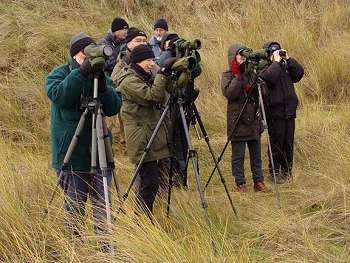 A good turnout on
Sunday (14th.) for our annual trip up to the Southport area, first to the
RSPB's Reserve at Marshside, followed by a short drive across the mosses to
Martin Mere. Marshside was as cold as usual, the temperature wasn't too warm to
start with, only about 7 degrees, and outside the nice warm hide, with a biting
wind sweeping across the Ribble estuary we enjoyed Spitzbergen like conditions,
giving three of the party a preview of what they're in for in June!! The whole
area was alive with birds, Mallard, Pintail, Shoveler, Teal, Shelduck and many
thousands of Wigeon, all kept constantly on the move by a couple of hungry
Peregrine Falcons that refused to give them any time to settle and feed. On the
opposite side of the road to the hide, on the salt-marsh, things were a little
quieter and a well hidden flock of Pinkfeet fed undisturbed, in the far
distance a ring-tailed Hen Harrier quartered the area, whilst just in front of
us a Stonechat went about it's business in relative safety.
A good turnout on
Sunday (14th.) for our annual trip up to the Southport area, first to the
RSPB's Reserve at Marshside, followed by a short drive across the mosses to
Martin Mere. Marshside was as cold as usual, the temperature wasn't too warm to
start with, only about 7 degrees, and outside the nice warm hide, with a biting
wind sweeping across the Ribble estuary we enjoyed Spitzbergen like conditions,
giving three of the party a preview of what they're in for in June!! The whole
area was alive with birds, Mallard, Pintail, Shoveler, Teal, Shelduck and many
thousands of Wigeon, all kept constantly on the move by a couple of hungry
Peregrine Falcons that refused to give them any time to settle and feed. On the
opposite side of the road to the hide, on the salt-marsh, things were a little
quieter and a well hidden flock of Pinkfeet fed undisturbed, in the far
distance a ring-tailed Hen Harrier quartered the area, whilst just in front of
us a Stonechat went about it's business in relative safety.
As tradition demands we lunched at Martin Mere, this time informing the staff
that we would leave our rucksacks in a corner, then collect them later - last
year we omitted to tell them of this preference and initiated the Reserves
first bomb scare - better to be sure than sorry! 1,300 Whooper Swans made a
fine sight gathered in front of the hides, we even managed to find 4 Bewick's
amongst them - mum and dad with 2 youngsters, further out amongst the Pinkfeet
a solitary Red-breasted Goose was giving many a "life tick" -
different strokes for different folks!
Some people know I've been having problems with my computer (yet) again, thanks
to John Somerville for helping me keep the "Latest News"
approximately up-to-date, although everything was backed up a corrupt floppy
meant I've lost all my e-mail addresses - so apologies to those who normally
receive an update when the website is updated and have been wondering what's
gone wrong - it's my fault! You may want to
register again. The computer has received a warning about it's future
conduct and if it refuses to behave it'll have the same prospects as a
Christmas turkey or Carlisle United F.C.!
12/12/03 Budworth Mere continues to attract some quality birds; as well as the Great Northern Diver (now re-classified as a 2nd Winter bird, not juvenile ((note the moulting primaries on the photo below!)) two Bitterns are resident in the Coward Memorial reedbed and a fine little Firecrest has been seen on a number of occasions close to the observation screen, the Thursday group walked the area earlier in the week, pausing for long enough to record a nice flock of 14 Redpolls and a single Brambling. On Tuesday (9th.) we enjoyed a trip out to the Dee Estuary making Denhall Lane our first port of call, walking alongside Denhall Marsh as far as the Decca Pools we encountered the expected wildfowl including Wigeon, Teal, Mallard, Shoveler and Shelduck plus waders in the form of Redshank, Dunlin, Lapwing and a substantial flock of Golden Plovers, roosting with the Lapwings. It was here we met up with the first raptors, Kestrel, Sparrowhawk, Buzzard and a female Merlin that was mobbed by a flock of 100+ Jackdaws who escorted it from the premises in a blizzard of thrashing black wings. After a bag of chips in the excellent Parkgate chippie, we moved on to the area beyond the Old Baths where two more raptors were added to the days tally - a ring-tailed female or juvenile Hen Harrier quartering the marsh plus a Peregrine Falcon perched on a distant post, invisible to the naked eye but no problem for "Oscar" Derek's impressive new scope! A covey of 8 Grey Partridges skulked through the field behind us where we looked in vain for a Shorelark amongst a small flock of Skylarks, whilst back on the marsh 2 Little Egrets flew over a small group of Swans, all Mute except for 3 Whoopers - I suspect we'll see a few more this coming Sunday on the KOS trip to Martins Mere! Another Winter Swan, this time at Melchett Mere in Tatton where Peter Rhodes, a birder from Bramhall, had a single Bewick Swan last week plus the 2 resident Stonchats and a Mandarin Duck on the main mere.
The KOS Christmas Party was held on the 12th December 2003. View pictures.
04/12/03 With the temperature into double
figures this week one or two species were prompted into song; in Tatton, on
Monday, a Mistle Thrush sang for a few minutes in Dog Wood, with a second bird
the following morning along Pavement Lane
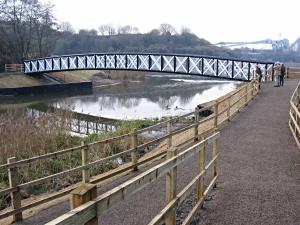 in Mobberley, along
with a Coal Tit tuning up in a small Scots Pine in a garden at the rear of a
house along Bucklow Avenue. We were pleased to find the route round the
Anderton Reserve at Northwich open once again now the splendid new footbridge
has been completed (right). We parked as usual at the Northwich car
park, but started our walk by entering the newly opened part of the Reserve
through an impressive set of wrought iron gates - this area is apparently
called Carley Park, but we christened it Rotorua due to
the still active runs of pipework carrying hot water(?) that emitted jets of
vapour giving the place the impression of being geothermally active! The path
eventually lead down to the new bridge (Carden's Ferry Footbridge) from where
we were able to continue round the usual route past the Anderton Lift and on to
Haydyn Pool via the canal tow path. We encountered nothing of any consequence
all morning, but had good views of Reed Buntings and Goldcrests along the walk,
and at Haydyn Pool amongst hoards of Teal, we noted a Black-tailed Godwit and a
Green Sandpiper. The hide at Neumann's Flash was closed whilst a new structure
is erected as part of the ongoing improvements to the area. We talked to two of
the engineers involved who told us the new hide would be open soon and the
whole project completed in about 12 months time.
in Mobberley, along
with a Coal Tit tuning up in a small Scots Pine in a garden at the rear of a
house along Bucklow Avenue. We were pleased to find the route round the
Anderton Reserve at Northwich open once again now the splendid new footbridge
has been completed (right). We parked as usual at the Northwich car
park, but started our walk by entering the newly opened part of the Reserve
through an impressive set of wrought iron gates - this area is apparently
called Carley Park, but we christened it Rotorua due to
the still active runs of pipework carrying hot water(?) that emitted jets of
vapour giving the place the impression of being geothermally active! The path
eventually lead down to the new bridge (Carden's Ferry Footbridge) from where
we were able to continue round the usual route past the Anderton Lift and on to
Haydyn Pool via the canal tow path. We encountered nothing of any consequence
all morning, but had good views of Reed Buntings and Goldcrests along the walk,
and at Haydyn Pool amongst hoards of Teal, we noted a Black-tailed Godwit and a
Green Sandpiper. The hide at Neumann's Flash was closed whilst a new structure
is erected as part of the ongoing improvements to the area. We talked to two of
the engineers involved who told us the new hide would be open soon and the
whole project completed in about 12 months time.
I received an unexpected visit the other night from an old friend who many
people will remember - non other than Garry Healy, up from his new home in
Cornwall on a pre-Christmas visit to relatives in Knutsford. I don't think
there have been many new species recorded in Tatton Park since Garry left in
1996 and he still remains the only person to even have attempted birdwatching's
most severe test - the Tatton Challenge!
He plans to save up some cash during the Summer before embarking on another
adventure (remember the Philippines?) - this time to Iceland and a camping /
twitching expedition this September. Watch out Edward!!
28/11/03 The Great Northern Diver remains
at Budworth Mere and seems well settled, with luck it may stay with us for a
considerable time.
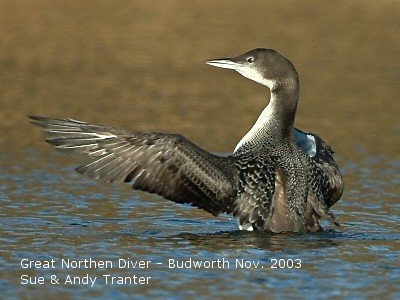 The bird is a juvenile and seems to relish the attention it's
getting! yesterday it was floating around with the Great Crested Grebes just a
few yards from the edge of the mere, close to the boat house, battleship grey
with that huge no-nonsense bill, occasionally slipping below the surface for
extended periods before re-appearing some time later a considerable distance
away. I was lucky enough to meet up with Sue and Andy Tranter from Leigh who
were photographing the bird using a digital SLR plus a huge 800mm telescopic
lens - they kindly sent me one of the images they captured (left), isn't
it brilliant? I find it difficult to believe that they've only been
photographing birds for the past 18 months! The SLR and a proper lens makes
things a lot easier than digiscoping using a camera with a telescope - but
perhaps a little more expensive! They have an excellent website containing more
quality images, it's at http://www.birdphotos.pwp.blueyonder.co.uk/
On our recent trip to the point of Ayr we saw a Black-tailed Godwit festooned
with rings - two on each leg, we were close enough to note all the markings and
these were sent away by Sheila Blamire to the BTO. Sheila has received an
interesting e-mail from the ringer, Tómas G. Gunnarsson
who's now at the School of Biological Sciences, University of East Anglia,
Tómas ringed the bird as an adult male on the 27th. April 2002 at
Grafarvogur near Reykjavic in south-west Iceland, and since then it has been
identified on a number of occasions, including 20/07/02 on the Dee Estuary only
3 days after being seen in Iceland.
The bird is a juvenile and seems to relish the attention it's
getting! yesterday it was floating around with the Great Crested Grebes just a
few yards from the edge of the mere, close to the boat house, battleship grey
with that huge no-nonsense bill, occasionally slipping below the surface for
extended periods before re-appearing some time later a considerable distance
away. I was lucky enough to meet up with Sue and Andy Tranter from Leigh who
were photographing the bird using a digital SLR plus a huge 800mm telescopic
lens - they kindly sent me one of the images they captured (left), isn't
it brilliant? I find it difficult to believe that they've only been
photographing birds for the past 18 months! The SLR and a proper lens makes
things a lot easier than digiscoping using a camera with a telescope - but
perhaps a little more expensive! They have an excellent website containing more
quality images, it's at http://www.birdphotos.pwp.blueyonder.co.uk/
On our recent trip to the point of Ayr we saw a Black-tailed Godwit festooned
with rings - two on each leg, we were close enough to note all the markings and
these were sent away by Sheila Blamire to the BTO. Sheila has received an
interesting e-mail from the ringer, Tómas G. Gunnarsson
who's now at the School of Biological Sciences, University of East Anglia,
Tómas ringed the bird as an adult male on the 27th. April 2002 at
Grafarvogur near Reykjavic in south-west Iceland, and since then it has been
identified on a number of occasions, including 20/07/02 on the Dee Estuary only
3 days after being seen in Iceland.
| And now for something completely
different! >>>>>>>>> For Sale Opticron Piccolo Mk2 ED telescope with jacket and cover(jacket cost £50 only a few months ago) + Cullman 3100 tripod . All the above for £190 o n o - An excellent scope for beginners at a realistic price. Contact 01565 653811 |
20/11/03 Terry Heath joined us on Tuesday
when we sneaked back to Bosley and took the elusive Great Grey Shrike by
surprise. It was showing well in the tall hawthorn hedges just beyond
"bridge 57", perching at times on the uppermost twigs, giving those
with sufficient skill and perseverance ample opportunity for some
"digiscoping".
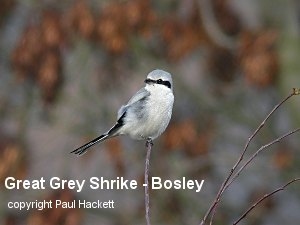 A Lesser Spotted Woodpecker had been seen further up the canal bank, we didn't
come across this but did have excellent views of a group of 6 Bullfinches and a
flock of c. 40 Siskins passing through. Nigel Troup had travelled over for the
Shrike on Sunday, he had good views of what was a "lifer" for him,
plus the bonus of the "Lesserpecker". Nigel has again had a look at
the fields on the perimeter of Woodford Airport at Adlington, he noted c.400
Lapwings, 200+ Golden Plover, Buzzard, 6 Skylarks and a small group of Tree
Sparrows. More of the latter over at Moss Brow Farm, Warburton where Dave
Clarke recorded 25, plus 12 Yellowhammers, 12 Goldfinches, 72 Chaffinches and
65 Meadow Pipits. Terry Heath has been doing the rounds of some of the local
waters and re-discovered a pair of Stonechats near Tatton's Melchett Mere,
perhaps the pair that spent last winter
in the park, whilst over a Budworth he was lucky enough to see a wintering
Bittern fly from the T.A. Coward memorial
reedbed right across to the far side of the Mere - Bitterns are frustrating
things, you know they're there but they spend hours hidden from view - at least
with a Shrike it's either there or it's not!
A Lesser Spotted Woodpecker had been seen further up the canal bank, we didn't
come across this but did have excellent views of a group of 6 Bullfinches and a
flock of c. 40 Siskins passing through. Nigel Troup had travelled over for the
Shrike on Sunday, he had good views of what was a "lifer" for him,
plus the bonus of the "Lesserpecker". Nigel has again had a look at
the fields on the perimeter of Woodford Airport at Adlington, he noted c.400
Lapwings, 200+ Golden Plover, Buzzard, 6 Skylarks and a small group of Tree
Sparrows. More of the latter over at Moss Brow Farm, Warburton where Dave
Clarke recorded 25, plus 12 Yellowhammers, 12 Goldfinches, 72 Chaffinches and
65 Meadow Pipits. Terry Heath has been doing the rounds of some of the local
waters and re-discovered a pair of Stonechats near Tatton's Melchett Mere,
perhaps the pair that spent last winter
in the park, whilst over a Budworth he was lucky enough to see a wintering
Bittern fly from the T.A. Coward memorial
reedbed right across to the far side of the Mere - Bitterns are frustrating
things, you know they're there but they spend hours hidden from view - at least
with a Shrike it's either there or it's not!
***** another stop press - Great Northern Diver - Budworth Mere - Today (21st) *****
17/11/03 Two "twitches" during
the past week, nothing serious of course; both concerned only "semi -
rarities" and were available locally, we were lucky with one and
"dipped" on the other (I think that's the term - although an old
friend of mine, Billy Macaig, who spent many years in the Royal Navy, always
said it had another meaning!).
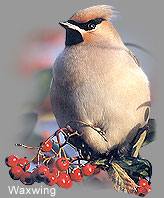 On Tuesday (11th.) we
travelled to see the Great Grey Shrike up at Bosley; taking the Macclesfield to
Leek road we turned right at Bosley cross-roads, down the A54, parking where
the road passes over the Macclesfield Canal and then walked south along the
towpath as far as bridge number 57. Unfortunately the Shrike wasn't around
although it was there the previous day and has been giving good views ever
since! Nevertheless it's a beautiful location and will be well worth a visit in
the Spring, I think a circular route will be possible - with the added bonus
that being a canal walk it's mostly on the flat and will appeal to all holders
of bus passes!! On Friday (14th) we were lucky and had no trouble at all
locating Macclesfield's flock of 6 Waxwings, in fact they were in view as we
parked the car at B&Q and subsequently allowed a really close approach as
they fed in Rowan trees along Crossall Street, behind the Mercedes Garage. Two
ladies with telescopes arrived and the views through these were exceptional as
the birds stopped feeding and rested in the uppermost branches of the Rowans,
calling quietly to each other with a constant, soft, ringing burble - I've seen
the species quite a few times over the years but never been close enough to
hear these contact calls.
On Tuesday (11th.) we
travelled to see the Great Grey Shrike up at Bosley; taking the Macclesfield to
Leek road we turned right at Bosley cross-roads, down the A54, parking where
the road passes over the Macclesfield Canal and then walked south along the
towpath as far as bridge number 57. Unfortunately the Shrike wasn't around
although it was there the previous day and has been giving good views ever
since! Nevertheless it's a beautiful location and will be well worth a visit in
the Spring, I think a circular route will be possible - with the added bonus
that being a canal walk it's mostly on the flat and will appeal to all holders
of bus passes!! On Friday (14th) we were lucky and had no trouble at all
locating Macclesfield's flock of 6 Waxwings, in fact they were in view as we
parked the car at B&Q and subsequently allowed a really close approach as
they fed in Rowan trees along Crossall Street, behind the Mercedes Garage. Two
ladies with telescopes arrived and the views through these were exceptional as
the birds stopped feeding and rested in the uppermost branches of the Rowans,
calling quietly to each other with a constant, soft, ringing burble - I've seen
the species quite a few times over the years but never been close enough to
hear these contact calls.
12/11/03 Sundays KOS trip to the
Point of Ayr
and Gronantwas a great success and I can see it becoming a regular venue
for the Society in years to come.
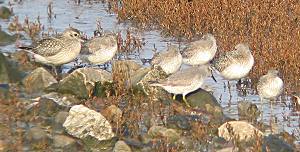 We arrived shortly
before 10am. after a drive of only 45' from Knutsford via the M56 and the A548,
after parking the cars we made our way eastwards along the embankment towards
the RSPB hide which is situated about half a mile along the estuary, looking
over towards Hilbre Island and the Wirral. The high tide ( at around 9.1 meters
quite a big one) was due around 11:00am and as we arrived at the hide great
flocks of waders had already gathered together to sit out the high water; most
numerous were the Oystercatchers of which there were many hundreds, followed in
descending order by Black-tailed Godwits, Knot, Curlew and Redshanks. In
smaller numbers we noted Ringed Plovers, Dunlin, Grey Plovers and a single
Spotted Redshank - discovered by a member of the party who had remained
unusually patient for 90 minutes or so before succumbing to the lure of a
chippy we'd noticed near to where we'd parked and to where he'd retired for a
pie and chips takeaway! 4 Red-breasted Mergansers floated past close to the
front of the hide giving excellent views, whilst further out were small numbers
of Pintail, Shoveller, Teal and Mallard - we didn't see large numbers of
passerines, just a few Meadow Pipits and Linnets but were amazed just past high
water when 2 Swallows flew past the hide, low over the sea, then away
inland - 9th. of November - now that's late!
We arrived shortly
before 10am. after a drive of only 45' from Knutsford via the M56 and the A548,
after parking the cars we made our way eastwards along the embankment towards
the RSPB hide which is situated about half a mile along the estuary, looking
over towards Hilbre Island and the Wirral. The high tide ( at around 9.1 meters
quite a big one) was due around 11:00am and as we arrived at the hide great
flocks of waders had already gathered together to sit out the high water; most
numerous were the Oystercatchers of which there were many hundreds, followed in
descending order by Black-tailed Godwits, Knot, Curlew and Redshanks. In
smaller numbers we noted Ringed Plovers, Dunlin, Grey Plovers and a single
Spotted Redshank - discovered by a member of the party who had remained
unusually patient for 90 minutes or so before succumbing to the lure of a
chippy we'd noticed near to where we'd parked and to where he'd retired for a
pie and chips takeaway! 4 Red-breasted Mergansers floated past close to the
front of the hide giving excellent views, whilst further out were small numbers
of Pintail, Shoveller, Teal and Mallard - we didn't see large numbers of
passerines, just a few Meadow Pipits and Linnets but were amazed just past high
water when 2 Swallows flew past the hide, low over the sea, then away
inland - 9th. of November - now that's late!
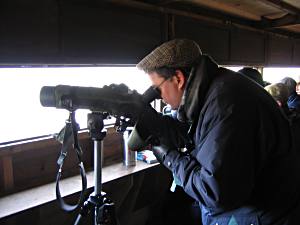 We enjoyed lunch
back at the cars; some had the sandwiches they'd bought, others - less
disciplined, availed themselves of the facilities discussed above, 80p for
chips and 50p for pies is good value and a lot less than what we pay round
here! Suitably refreshed we drove the short distance down the coast to Gronant
where we found that the car park recommended on the
Dee Estuary
website seemed to have been appropriated by the pub across the road, so we
took a chance and parked in the Presthaven Caravan Park, and if challenged we
would claim to be considering the purchase of one of their "top of the
range" models. We walked a circular route of around 1 ½ miles at a
slow birdwatchers pace through areas of salt-marsh, sand dunes and reedbeds;
one of the first birds we saw was a fine male Stonechat hawking for unseen
insects from the top of a hawthorn bush, Linnets and Meadow Pipits flew
overhead and at one point a Twite also passed over, perhaps disturbed by the
resident Merlin which proved very cooperative posing confidently in front of
the telescopes pointed in its direction. It was late afternoon before we headed
back across the border after an excellent days birding, we'd seen all the
expected species, plus one or two more, but missed out on 2 Shorelarks that
were seen at Gronant later in the day - perhaps next time.
We enjoyed lunch
back at the cars; some had the sandwiches they'd bought, others - less
disciplined, availed themselves of the facilities discussed above, 80p for
chips and 50p for pies is good value and a lot less than what we pay round
here! Suitably refreshed we drove the short distance down the coast to Gronant
where we found that the car park recommended on the
Dee Estuary
website seemed to have been appropriated by the pub across the road, so we
took a chance and parked in the Presthaven Caravan Park, and if challenged we
would claim to be considering the purchase of one of their "top of the
range" models. We walked a circular route of around 1 ½ miles at a
slow birdwatchers pace through areas of salt-marsh, sand dunes and reedbeds;
one of the first birds we saw was a fine male Stonechat hawking for unseen
insects from the top of a hawthorn bush, Linnets and Meadow Pipits flew
overhead and at one point a Twite also passed over, perhaps disturbed by the
resident Merlin which proved very cooperative posing confidently in front of
the telescopes pointed in its direction. It was late afternoon before we headed
back across the border after an excellent days birding, we'd seen all the
expected species, plus one or two more, but missed out on 2 Shorelarks that
were seen at Gronant later in the day - perhaps next time.
**** STOP PRESS ****
The Thursday group report good views of 6 Waxwings this afternoon on Crossall
Street, Macclesfield - near to B&Q!!
06/11/03 Winter Swans (Bewick's and \ or
Whooper) turn up most years somewhere in the area during the Winter months;
occasionally, like the 4 Whoopers at Marthall in December 2000, they'll remain
with us in small numbers for days or weeks at a time, but normally they pass
quickly through on their way to more productive locations. I can't remember
what year it was, but one morning in March I'd just parked my old grey mini-van
at work in Mobberley (so we're looking at the mid-seventies) when a colleague
drew my attention to some birds approaching from the west; they seemed to
stretch almost from horizon to horizon such was the size of the flock - they
were Bewick's Swans - a long straggling flock, well into 3 figures and just
setting off on their long migration back to their breeding grounds high on the
Arctic tundra: experiences like that you just don't forget!
Enough though of the past (but what's left when you're two months short of your
first bus pass!!) and back to the present, Pete Hall had 5 Winter Swans near to
Toft Pool on Tuesday (4th.) he was on a tractor at the time and didn't have his
binoculars to hand so he couldn't specifically identify them. Perhaps they were
Whoopers that had overflown Martin Mere where I believe there are currently 800
birds newly arrived from Iceland, no doubt we'll find even more there in
December on what has become our annual KOS trip to the Reserve. Before then
though we have our November field trip this coming Sunday (9th.) to the Point
of Ayr - a brave choice by the committee for November! on this occasion we may
be lucky, the Met. office is predicting that the dry spell will continue with
daytime temperatures in double figures and relatively light winds from the
south - east : Snow Buntings would be nice!
While I was searching in vain for the date of the great Bewick flock I came across this article by Bill Mulligan - it took nearly 30 years but they finally made it!
31/10/03 The birds seem to appreciate John
Erlam's decision to go completely "organic" at Sugar Brook Farm, [
map ] we spent a
pleasant 3 hours strolling round the perimeter on Tuesday (28th.) and were
pleased to see so much activity compared to what we're used to on other local
farms. The large field in front of the farm contained oats this year and is now
supporting a substantial flock of finches, we counted at least 100, mainly
Chaffinches but also a few Greenfinches and Goldfinches, as the seasons
progress we may eventually see many more, John has created an ideal environment
for them. There were plenty of Redwings, Fieldfares, Blackbirds and Mistle
Thrushes feeding in the Hawthorn hedges, plus Goldcrests, Tree Sparrows, a few
Bullfinches and a single Song Thrush, mainly around the edges of the big field
next to the Altrincham to Chester railway line, this was set-aside in 2003 but
next year it will be sown with native grasses and left to the sheep. A Barn Owl
has been seen in the area and John is planning to provide nesting facilities in
one of the farm buildings, additionally 100 Tree Sparrow nest boxes are under
construction and will be positioned in clusters at suitable locations around
the farm.
My supposition that last weeks Concorde flight into Manchester Airport would be
the last was not entirely accurate - in fact it was wrong! It was announced
this week that Manchester had been chosen to be the final resting place for one
of the British Airways Concordes and today this aircraft flew into the airport
for definitely the last time. Last week I videoed the event, but of
course you don't get a very good view through the eyepiece of a video camera,
so I decided today just to take a few shots with a still camera. Which one to
use though - the new digital camera or the trusty Canon T70 - the new camera is
also a Canon, the A80 and described in the magazines as ....... entry level
........... ideal for a beginner etc. oh really? - the instruction manual runs
to 214 pages and that's just for the camera, the software starter guide is
another 118 !! so I chose the traditional route and put some film in the T70.
To cut a long story short it jammed - just as the plane reached a perfect
position, filling the viewfinder, the shutter stuck open ! So that's me and
film finished - now where's that manual?
23/10/03 No reports so far this week any
hirundines in our immediate area, although there is a chance that the odd House
Martins will still be seen; we've had them into November in previous years.
Work on the new bridge across Witton Brook continues to drag on, so on Tuesday
we were unable to walk right round the Anderton Reserve
[map] but enjoyed strolling
across the new path that cuts across the middle of the reserve where Winter
Thrushes were much in evidence, with Redwings, Fieldfares, Blackbirds and good
numbers of Mistle Thrushes feeding on a diminishing supply of Hawthorn berries.
Haydn pool was quiet, about 80 Teal on the water and a single Dunlin on the mud
were the only occupants of note, whilst across the road on Neumann's Flash we
noted a small selection of Black-headed, Lesser Black-backed and Common Gulls
plus one Redshank, 3 Golden Plovers and a lone Lapwing; Ruff and a Little Stint
were entered in the log book, but appeared to have moved on.
Mobberley Road linking Knutsford and Mobberley came to a standstill yesterday
(22nd.) with cars parked (or seemingly dumped!) along a stretch between Shaw
Heath and the village. It resembled a giant twitch, hundreds of people had
de-camped and were lining the roadside, all staring in the same direction -
south west and up into the air - binoculars and cameras out of their cases,
ready for instant use - there was an exited mood of anticipation - what was it
that had caused such frenetic activity? . Well it was a bird of sorts -
they were all waiting to pay their final respects to Concorde on it's final
tour of the UK and yesterday flying into Manchester Airport for the last time;
10,000 people were at the airport itself and probably almost as many on the
route of it's final approach to Runway1. The easterly winds that has brought us
so many Winter Thrushes from Scandinavia and beyond meant that landing aircraft
had to pass over Knutsford and Mobberley prior to landing - hence all the
crowds. Now I'm not too interested in aviation - I've got enough time wasting
hobbies - but you have to concede that this ultimate example of 60's British
and French innovation and engineering skill is so
impressive - a little bit of history being enacted in the sky over Mobberley.
I'll remember it.
17/10/03 Despite being well into October Swallows are still being reported from widespread locations. Pete Hall's last family left Toft Hall Farm on the 10th, but he had 5 over the same location 2 days later. Derek and Sheila noted 1 bird over the Oxmoor LNR during a visible migration watch the same morning and on Tuesday (14th.) we saw 4 birds flying south over the Moore Nature Reserve near Warrington. Replacing these Summer visitors are our Winter Thrushes, now back with a vengeance, encouraged over the Pennines by a series of cloudless nights combined with strong easterly winds. Nigel Troup had his first Redwings of the Autumn on the 7th in Davenport (Stockport) whilst two days later on the 9th. Redwings and Skylarks were passing over Mobberley at first light and Pete Hall reports seeing good numbers of newly arrived Song Thrushes at the same time. It was Monday 13th. when the real influx took place, flocks of Redwings and Fieldfares were seen in Mobberley while over in Toft Pete estimated 4 - 500 birds an hour were passing over the farm, heading in a south-westerly direction, on one occasion 5 Bramblings were heard calling from amongst the hordes of Thrushes - easy to identify if you know the call, but they remain anonymous if you're relying on visual identification alone.
09/10/03 We had the first real gales of the
Autumn earlier in the week and on Tuesday morning (7th.), after overnight
gales, we made our way on out to the coast in search of waifs and strays,
forced close to the shore by the extreme conditions.
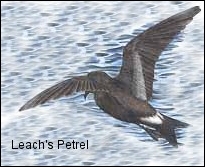 Many years ago
Bill Mulligan introduced us to a spot on the
promenade at Meols (pronounced Mells) where I
remember seeing Leach's Petrel Petrel and Sabine's Gull for the first time, and
had the drivers door of the old mini van almost ripped off by a sudden gust of
wind! Conditions weren't as bad as that on Tuesday, but we still needed to get
out of the wind in order to set the telescopes up and found ourselves in the
the same shelter we'd used all those years ago with Bill! It's one of those
uniquely British structures, in the shape of a capital letter "I"
that affords shelter no matter which direction the wind is coming from; beloved
of pensioners at seaside locations throughout the UK, passing the days watching
the world go by - in our case it was the birds we were watching pass by, and
perhaps some of the group would (quite correctly) deny being old enough to
qualify for a bus pass and Winter heating allowance! The sea didn't come right
in, so we had some sand in front of us and flocks of waders were huddled
together sitting out the tide, there were Dunlin, Oystercatchers, Curlew and
Redshanks - all in good numbers and neatly arranged in groups of the same
species. The sea looked very wild and a picture I saw later taken on the
morning in question suggested that the waves were up to 20' in height, birds
appeared briefly over the surf before vanishing almost immediately then
reappearing 100's of yards away! We saw a single Red-throated Diver, 5
Shearwaters (probably Manx) and a very distant Arctic Skua; fortunately the
Leach's Petrels - the birds we'd been hoping to see were more accommodating and
after only a few minutes the first of 5 appeared, giving good views for more
than a minute as it passed slowly along the shoreline and away over the boiling
surf towards Hilbre Island.
Many years ago
Bill Mulligan introduced us to a spot on the
promenade at Meols (pronounced Mells) where I
remember seeing Leach's Petrel Petrel and Sabine's Gull for the first time, and
had the drivers door of the old mini van almost ripped off by a sudden gust of
wind! Conditions weren't as bad as that on Tuesday, but we still needed to get
out of the wind in order to set the telescopes up and found ourselves in the
the same shelter we'd used all those years ago with Bill! It's one of those
uniquely British structures, in the shape of a capital letter "I"
that affords shelter no matter which direction the wind is coming from; beloved
of pensioners at seaside locations throughout the UK, passing the days watching
the world go by - in our case it was the birds we were watching pass by, and
perhaps some of the group would (quite correctly) deny being old enough to
qualify for a bus pass and Winter heating allowance! The sea didn't come right
in, so we had some sand in front of us and flocks of waders were huddled
together sitting out the tide, there were Dunlin, Oystercatchers, Curlew and
Redshanks - all in good numbers and neatly arranged in groups of the same
species. The sea looked very wild and a picture I saw later taken on the
morning in question suggested that the waves were up to 20' in height, birds
appeared briefly over the surf before vanishing almost immediately then
reappearing 100's of yards away! We saw a single Red-throated Diver, 5
Shearwaters (probably Manx) and a very distant Arctic Skua; fortunately the
Leach's Petrels - the birds we'd been hoping to see were more accommodating and
after only a few minutes the first of 5 appeared, giving good views for more
than a minute as it passed slowly along the shoreline and away over the boiling
surf towards Hilbre Island.
2/10/03 On Monday (29th Sept.) at around 07:45am there appeared to be a substantial movement of birds over Mobberley, 4 flocks of c15 - 20 LBJs a couple of hundred feet up flying north to south - they didn't call (which may or may not have helped!) but this encouraged me to take a trip up to the Pennines to see if I could see anything in the way of visible migration, a phenomena that currently seems to fascinate so many birdwatchers. It's nothing new, people have been counting birds for a long time, especially along the coast at observatories, but it has become more organised of late with people using the Internet to pass information to and fro especially some observers up in the hills of northern England. I arrived at Pym Chair ( around 1500' asl and overlooking the Cheshire plain) at 9:15am; perhaps it was a little late in the day but in half an hour I saw only 1 Meadow Pipit and a few Jackdaws, plus plenty of Red Grouse, but I don't suppose they were on passage to warmer climes! Thinking about it, I came to the conclusion that birds may to prefer to use the valleys as much as possible, rather than fly over the high moorland, so I went down from Pym Chair to the Goyt Valley, only a mile or so away but a lot lower and here I saw more of interest. A flock of 40 House Martins were feeding over Errwood Reservoir as I arrived - I had to assume they were passing through and weren't local, because there are few nesting sites in the area and over a period of 5 minutes they departed, down the valley towards the south. Other species were migrating through, I saw two pairs of Swallows just below tree top height powering along, plus a flock of 10 small thrushes, glimpsed for a few seconds before they to headed over towards the "Cat & Fiddle", I suspect they were Redwings. More of a problem were the Siskins overhead in the roadside conifers - they may have been passing through but were probably there for the Winter or until forced lower by any bad weather that may eventually be coming our way. Most interesting, but you do need to know an area and its birds well enough to tell the difference between normal movements and actual migration, and there's no shortcuts here, it's practical knowledge built up by careful observations over a long period of time - thankfully books and the Internet will be of little help, you have to cut the umbilical cord and get out there! Pete Hall is one of the few people I know who's done this and his knowledge of the Toft area and its wildlife is quite remarkable - this week he reports a single Redwing on the 30th., the first this Autumn in the Knutsford area plus 6 Swallows still in the yard at Toft Hall Farm, and a small passage of Skylarks in the mist early today, taking advantage of the current easterly winds.
25/09/03 Autumn arrived quite suddenly this week as a low pressure system passed from north to south over the UK dragging behind it strong winds straight from the Arctic. At Mobberley SQ a large flock of Jackdaws were enjoying the blustery spell, hanging in the updraft of air generated as the wind was forced upwards by the high bank at the far side, many would have been birds of the year revelling for the first time in conditions that this species seem to enjoy so much. The Green Sandpiper had returned to the muddy margins of the pool, we've seen in the past that they will remain faithful to an area if there is more than one suitable habitat available, so they have somewhere to go when disturbed - they're very shy creatures. The Thursday Group perhaps came across one of these alternative sites when they flushed two Green Sandpipers from a small pond in the Fox Harbour area of Mobberley, also here they put up a Snipe that did a quick circuit of the area, before diving into cover a few yards from where they stood - this suggests it was a Jack Snipe - the Common Snipe will invariably tower into the air before leaving the area completely. The first Pink-footed Geese of the season have arrived from Iceland, Sheila Blamire had a small flock over Mere earlier in the week and yesterday (25th.) a group of 9 passed over high over Pavement Lane Mobberley where earlier today a plaintive call drew my attention to a lone Golden Plover, down from the hills heading steadily west, perhaps it was heading to Neumann's Flash where, on Tuesday, we counted 19 amongst a flock of 850 Lapwings. Our Hobbies seem to have departed after what appears to have been a most successful breeding season, Derek Pike had 2 birds on Monday evening, but there have been no sightings since then - so the year is progressing quickly, we'll no doubt get the first Redwings soon, we'd had the first birds already this time last year.
17/09/03 The Green Sandpiper and remaining Greenshank have finally moved on after more than two weeks at Mobberley SQ, they seemed to have established a symbiotic relationship and for most of the time were to be found within a few yards of each other whenever we walked down to have a look at them. We had both species again last Sunday on the KOS trip to the RSPB's Reserve at Fairburn Ings across the Pennines in Yorkshire where 2 Greenshank and a single Green Sandpiper shared "Spoonbill Flash" with 4 Ruff, 4 Dunlin and a handful of Snipe. The main areas of water to the east of the information center held large numbers of wildfowl, mostly in juvenile / eclipse plumage, which was making life difficult for the Warden trying to carry out the monthly count, he'd counted 65 Tufted Ducks, 130 Teal, 95 Wigeon and no less than 170 Gadwall. Hirundines were on the move, with a steady stream passing through all day, locally our Swallows have left this week and over in Toft Pete Hall reports his last brood fledging during the past few days, they've been with us now for six months, remember that really early Swallow in March that waited so long for company as a high pressure weather system built up over the Country, forcing all the weather from the west to take a lower track over the Mediterranean, and in doing so holding up many of our Summer visitors on their way north. They probably made up for lost time such was quality of the Summer we've just enjoyed - in fact the late Summer we're still enjoying - the afternoon temperature has reached 25ºC every day this week.
11/09/03 A disappointing morning on Tuesday (9th) when we
walked a circular route round Tatton Park,
starting at the Dog Lodge lay-by on Mobberley road and making our way across
Knutsford Moor to the Knutsford Gate,
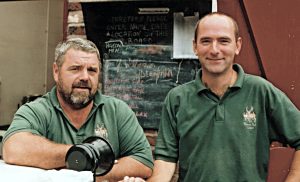 before proceeding
along Beech Walk, round the back of Melchett Mere and through Dog Wood back to
the start. The weather didn't help, one minute we were being drenched by
torrential rain, the next peeling off the waterproofs as the sun came out and
reminded us that Summer's still hanging on and there's no need to dig the snow
chains out just yet! There was some evidence of passage with Swallows and House
Martins passing through over the main Mere, whilst overhead we heard the
occasional squeaky calls of migrating Meadow Pipits, half way round we met up
with two of Tatton's Wardens, Richard and Darren (left) who we
admonished (as usual) for not coming up with any decent sightings for
absolutely ages!
before proceeding
along Beech Walk, round the back of Melchett Mere and through Dog Wood back to
the start. The weather didn't help, one minute we were being drenched by
torrential rain, the next peeling off the waterproofs as the sun came out and
reminded us that Summer's still hanging on and there's no need to dig the snow
chains out just yet! There was some evidence of passage with Swallows and House
Martins passing through over the main Mere, whilst overhead we heard the
occasional squeaky calls of migrating Meadow Pipits, half way round we met up
with two of Tatton's Wardens, Richard and Darren (left) who we
admonished (as usual) for not coming up with any decent sightings for
absolutely ages!
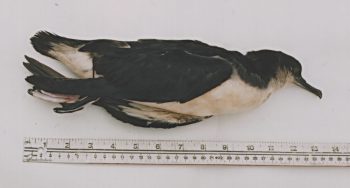 Well
that certainly seemed to do the trick because the following morning I received
a call from Darren who was stood at the side of Tatton Mere actually holding in
his arms a real Tatton rarity and a bird that doesn't feature on anyones Tatton
tick list (as far as I know) - it was a Manx Shearwater! Now it's not unheard
of for this particular species to occur inland - it's unusual but they are
sometimes discovered after very fierce Autumn gales, but of course we haven't
had any so far this year, so that's not an explanation in this case. Some years
ago a Little Shearwater was found on Rostherne Mere, this is even rarer, a real
CMF, but it was in poor condition and died shortly after being taken from the
water. Wednesday's bird though seemed to be in good condition, plump and heavy,
but alas not street-wise - it was taken by a visitor's Greyhound and succumbed,
despite being rescued by Darren. After taking some measurements and photos to
confirm it's identification the bird was placed in a plastic bag and put into a
freezer until it can be taken for examination to determine it's state of health
immediately prior to it's death.
Well
that certainly seemed to do the trick because the following morning I received
a call from Darren who was stood at the side of Tatton Mere actually holding in
his arms a real Tatton rarity and a bird that doesn't feature on anyones Tatton
tick list (as far as I know) - it was a Manx Shearwater! Now it's not unheard
of for this particular species to occur inland - it's unusual but they are
sometimes discovered after very fierce Autumn gales, but of course we haven't
had any so far this year, so that's not an explanation in this case. Some years
ago a Little Shearwater was found on Rostherne Mere, this is even rarer, a real
CMF, but it was in poor condition and died shortly after being taken from the
water. Wednesday's bird though seemed to be in good condition, plump and heavy,
but alas not street-wise - it was taken by a visitor's Greyhound and succumbed,
despite being rescued by Darren. After taking some measurements and photos to
confirm it's identification the bird was placed in a plastic bag and put into a
freezer until it can be taken for examination to determine it's state of health
immediately prior to it's death.
06/09/03 Nice to meet up once again this
week with our Icelandic correspondent Edward Rickson over from Reykjavik to
visit his parents in Cheadle. As usual Edward asked us to to provide him with a
new species for his ever expanding "tick list" - last year it was
Willow Tit, and this proved quite a challenge on the day we tried for it,
eventually finding a single bird at Sandmere on our last stop of the day. This
time it was relatively easy as Edward confessed to never having seen Hobby in
the UK, up until a couple of years ago this would have meant a long trip to the
south of England, but with the continuing expansion in the range of this
species we were able to visit our own family and once
again enjoy good views of both adult and juvenile birds. (NB these birds are
viewable from a public footpath used by 100's of people and at no time was the
nest site approached (it wasn't looked for or known, the young are free
flying)- just in case anyone starts whinging about disturbing a schedule 1
species at the nest!). A short time later we were able to give our guest a
bonus in the form of a Spotted Redshank on Neumann's Flash in Northwich,
surprisingly this is only a rare
vagrant in Iceland. Two
more Spotted Redshanks on Wednesday (3rd.) when we visited Inner Marsh Farm on
The Wirral - the RSPB's best kept secret! - in contrast to the juvenile bird at
Northwich, these were adults with grey plumage and no barring on the
underparts. The Reserve was full of birds, we missed out on the Wood Sandpiper
which had been seen earlier in the morning but we were treated to excellent
views of Water Rail, Ringed Plover, Common Sandpiper, c. 130 Black-tailed
Godwits, c. 15 Greenshanks and a few common Snipe. From IMF we drove on to
Parkgate but failed to find anything of interest, consoling ourselves with some
homemade ice creams and a visit to the town's only remaining sea food shop.
Nearer to home the Green Sandpiper and a single Greenshank remain on Mobberley
SQ, they were joined on Friday morning by a Ruddy Shelduck!
I took the video camera round to Geoff and Sheila's during the week and Geoff
kindly showed me how to transfer the pictures to computer, do some basic
editing then transfer them to CD in a format that can be uploaded to the
internet - the fruits of our labour can be viewed
here!
02/09/03 A group of 20 members on a fine
and sunny Sunday morning for the long trudge across the sands of Dee to
Hilbre Island for what has
become our annual late August visit.
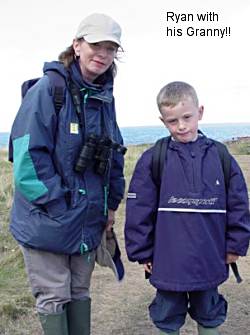 The pleasant weather meant that
we were never going to see much in the way of pelagic species although one or
two people did a bit of sea-watching around the time of high tide and managed
distant views of Gannet, Red-throated Diver, Guillemot, Razorbill and a small
flock of 6 Common Scoters, but we saw no Shearwaters, Petrels or Skuas
The pleasant weather meant that
we were never going to see much in the way of pelagic species although one or
two people did a bit of sea-watching around the time of high tide and managed
distant views of Gannet, Red-throated Diver, Guillemot, Razorbill and a small
flock of 6 Common Scoters, but we saw no Shearwaters, Petrels or Skuas
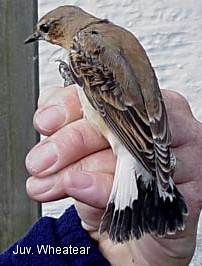 and
only single Common, Sandwich and Little Terns during the whole day. There were
a few passerines on the main island including a flock of 20 Linnets and good
numbers of migrating Wheatears, one of which had been caught by the ringers,
along with a juvenile Common Whitethroat and they kindly allowed the troops a
close look at these two little travellers prior to their release. The waders
once again saved the day, and with a very high tide they were roosting in good
numbers only a few yards from the assembled observers and we had really good
views of some species that we only see on an occasional basis inland around the
Knutsford area. As usual the Dunlins and Ringed Plovers were the most numerous,
and these two species crowded together on the sandstone ledges of the main
island sitting out the tide. Redshanks and Turnstones were around in smaller
numbers, as were the Oystercatchers roosting over on the Middle Eye, whilst
inconspicuous amongst the Dunlin one or two Sanderlings and a single Knot,
forerunner of the thousands that will arrive in the weeks to come. We nearly
overlooked a tiny little bird roosting amongst the Dunlin, despite the fact
that it was resting only a few yards from where we were stood, it was a
juvenile Little Stint, down from the high Arctic to give such good views as it
enjoyed a few minutes well earned rest. For many though the bird of the day was
another wader, on its own feeding amongst the rocks and pools, even at high
tide - a Purple Sandpiper, constantly on the move like one of our woodland
Treecreepers, indifferent to the binoculars and 'scopes pointing in its
direction it provided good views and I even managed a few minutes of video, if
Geoff can show me how it's done I'll hopefully be able to save a few seconds to
disk and eventually put it up on this site!
and
only single Common, Sandwich and Little Terns during the whole day. There were
a few passerines on the main island including a flock of 20 Linnets and good
numbers of migrating Wheatears, one of which had been caught by the ringers,
along with a juvenile Common Whitethroat and they kindly allowed the troops a
close look at these two little travellers prior to their release. The waders
once again saved the day, and with a very high tide they were roosting in good
numbers only a few yards from the assembled observers and we had really good
views of some species that we only see on an occasional basis inland around the
Knutsford area. As usual the Dunlins and Ringed Plovers were the most numerous,
and these two species crowded together on the sandstone ledges of the main
island sitting out the tide. Redshanks and Turnstones were around in smaller
numbers, as were the Oystercatchers roosting over on the Middle Eye, whilst
inconspicuous amongst the Dunlin one or two Sanderlings and a single Knot,
forerunner of the thousands that will arrive in the weeks to come. We nearly
overlooked a tiny little bird roosting amongst the Dunlin, despite the fact
that it was resting only a few yards from where we were stood, it was a
juvenile Little Stint, down from the high Arctic to give such good views as it
enjoyed a few minutes well earned rest. For many though the bird of the day was
another wader, on its own feeding amongst the rocks and pools, even at high
tide - a Purple Sandpiper, constantly on the move like one of our woodland
Treecreepers, indifferent to the binoculars and 'scopes pointing in its
direction it provided good views and I even managed a few minutes of video, if
Geoff can show me how it's done I'll hopefully be able to save a few seconds to
disk and eventually put it up on this site!
28/08/03 The Spotted Redshank duly obliged
and we finally caught up with it on a visit to the Anderton Reserve [map] on Tuesday (26th.), it was frequenting
the Haydyn Pool and we had good enough views to see the extensive barring on
it's underparts, thereby identifying it as a juvenile bird. Also present on the
pool a Greenshank, feasting on an abundance of small amphibians, 2 snipe and a
juvenile Ringed Plover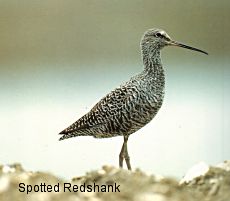 plus a
selection of eclipse wilfowl including Mallard, Tufted Duck, Teal, Shoveler and
Gadwall. I had a very pleasant surprise earlier today when I had a quick look
at Mobberley SQ (sand quarry), right in the middle of the village this area,
has turned up some excellent birds during the Spring and Autumn passage, but
the area of water has shrunk considerably and currently it's probably no more
than 50 yards across. Additionally it's been purchased by the Mobberley Parish
council who are not certain what to do with it - they just didn't want
"The Airport" to get their hands on it - so it's used a lot by dog
walkers and any birds present don't hang around too long. No dogs this morning,
perhaps due to the long grass and a steady drizzle, so the birds were taking
full advantage and I was delighted to see a Green Sandpiper and 2 fine
Greenshanks feeding on our own miniature Haydyn Pool! Paul Leigh went down
about an hour later and found the Greenshanks still there plus 13 Lapwings, 3
Snipe and a small flock of migrating Sand Martins. It's like finding gold in
your own back garden!
plus a
selection of eclipse wilfowl including Mallard, Tufted Duck, Teal, Shoveler and
Gadwall. I had a very pleasant surprise earlier today when I had a quick look
at Mobberley SQ (sand quarry), right in the middle of the village this area,
has turned up some excellent birds during the Spring and Autumn passage, but
the area of water has shrunk considerably and currently it's probably no more
than 50 yards across. Additionally it's been purchased by the Mobberley Parish
council who are not certain what to do with it - they just didn't want
"The Airport" to get their hands on it - so it's used a lot by dog
walkers and any birds present don't hang around too long. No dogs this morning,
perhaps due to the long grass and a steady drizzle, so the birds were taking
full advantage and I was delighted to see a Green Sandpiper and 2 fine
Greenshanks feeding on our own miniature Haydyn Pool! Paul Leigh went down
about an hour later and found the Greenshanks still there plus 13 Lapwings, 3
Snipe and a small flock of migrating Sand Martins. It's like finding gold in
your own back garden!
25/08/03 The traditional Swallow roost in the phragmites reeds on Knutsford Moor has declined somewhat over the past few years, they are taking advantage of changes in agricultural practice and now seem to favour the acres of maize growing throughout the area. Up to 500 have been using a field along Moss Lane, just to the west of Knutsford, numbers build up rapidly after sunset, the birds swirling nervously round over an area of about ½ square mile, each seemingly reluctant to be the first to land, but once one does so the rest follow immediately, it's a dangerous time - the flock has been the target of two Hobbies on more than one occasion over the past couple of weeks. Our Swifts have left early this year with only the odd bird noted this week moving rapidly south, perhaps the excellent Summer has allowed them to complete the breeding cycle quickly and given them the luxury of an early return in ideal conditions, they should be back in record numbers next year! Over in Toft Pete Hall reports a successful season for his Spotted Flycatchers - they brought off two broods and a pair of Pied Wagtails who raised three lots of youngsters - I think they deserve a rest, how many journeys back and forward to the nest did that entail! So as we move into September birds are on the move again, Pete had 3 Ravens flying west over the farm while Dave Clarke reports a juvenile Marsh Harrier over Warburton Wet Meadows, some good birds have been present in the Budworth / Anderton area with Black Tern, Garganey and Spotted Redshank all around over the past few days - I hope the Redshank stays around it's a splendid bird and I've not seen one for a long time.
20/08/03Len and Sheila finally made it back
to Cheshire - via North Uist! Rather a strange route to take but they did
manage to catch up with the magnificent Snowy Owl, seen here in Dave's superb
picture,
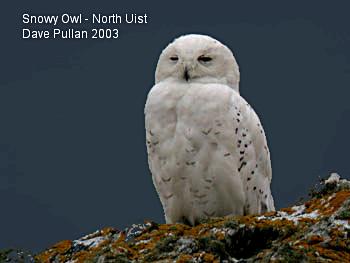 taken
with a digital camera attached to a telescope - digiscoping. Buying the
equipment is the easy part, acquiring the skill to obtain images like this is a
combination of hard work and a natural talent. So we had a full compliment for
Tuesday's morning stroll around a local bit of the
Knutsford area which, for the time being, will not be identified. Walking along
a little used public footpath we heard the sound of a raptor calling, it
revealed it's position as it flew from it's perch in an ash tree about 100
yards from where we had stopped - it was a juvenile Hobby! Moreover there was
more than the one bird, there was a family party, 2 adults and 2 juveniles. The
original bird from the ash tree flew up to an approaching adult and took food
from it in a spectacular mid-air food pass as the second youngster settled on a
fence post no more than 50 yards from us - we had beautiful views, even without
a 'scope it was possible to make out the buff edges to the feathers on the
young bird's back. I think we all felt privileged to share a few minutes with
these birds, they appeared not to be alarmed by our intrusion, in fact they
were only 200 yards or so from busy industrial units, nevertheless, not wishing
to overstay our welcome, we reluctantly moved on. The remainder of our route
continued through typical Cheshire farmland, grazing cows and fields of Spring
sown barley - not too much activity apart from a couple of coveys of Red-legged
Partridges until we came to a field that had been left for some reason,
presumably setaside, it was full of weeds especially Redshank and Pale
Persicaria and had attracted a nice flock of 38 Linnets plus a few Goldfinches,
I've not seen so many Finches at that location for many years - most
encouraging.
taken
with a digital camera attached to a telescope - digiscoping. Buying the
equipment is the easy part, acquiring the skill to obtain images like this is a
combination of hard work and a natural talent. So we had a full compliment for
Tuesday's morning stroll around a local bit of the
Knutsford area which, for the time being, will not be identified. Walking along
a little used public footpath we heard the sound of a raptor calling, it
revealed it's position as it flew from it's perch in an ash tree about 100
yards from where we had stopped - it was a juvenile Hobby! Moreover there was
more than the one bird, there was a family party, 2 adults and 2 juveniles. The
original bird from the ash tree flew up to an approaching adult and took food
from it in a spectacular mid-air food pass as the second youngster settled on a
fence post no more than 50 yards from us - we had beautiful views, even without
a 'scope it was possible to make out the buff edges to the feathers on the
young bird's back. I think we all felt privileged to share a few minutes with
these birds, they appeared not to be alarmed by our intrusion, in fact they
were only 200 yards or so from busy industrial units, nevertheless, not wishing
to overstay our welcome, we reluctantly moved on. The remainder of our route
continued through typical Cheshire farmland, grazing cows and fields of Spring
sown barley - not too much activity apart from a couple of coveys of Red-legged
Partridges until we came to a field that had been left for some reason,
presumably setaside, it was full of weeds especially Redshank and Pale
Persicaria and had attracted a nice flock of 38 Linnets plus a few Goldfinches,
I've not seen so many Finches at that location for many years - most
encouraging.
13/08/03 The record finally fell on Sunday (10th.) with a temperature of 38.1ºC reached at Gravesend in Kent, here in Cheshire it was raining at the time, our maximum was 33ºC on Friday - hot enough! We may see it higher eventually, but I don't think anyone reading this will be around when the next all-time low for the UK is recorded!. Beautiful weather in Scotland too where The Dynamic Duo have joined forces again with Dave Pullan in part two of their Scottish Grand Tour. A text message from Sheila reports 4 White-tailed Eagles, 4 Golden Eagles, Osprey, Hen Harrier, 6 Ravens and a Whimbrel all on the island of Mull on Sunday, followed the next day by Minke Whale, 6 Bonxies and 600 Manx Shearwaters whilst sailing to and from Eigg and Muck (Mason on a boat? they must have bribed him with a bottle or two of Red!) . Back on the mainland Sheila set up a moth trap at Dave's house in Nethybridge and trapped 36 species of which 5 were lifers - all before breakfast presumably and prior to a further ascent of Carn Ban Mor later in the day where 2 of the 3 had Ptarmigan and Dotterel, and the third enjoyed a few pints at a lower level! Meanwhile 3 members of the Tuesday group had a drive over to Sandbach for a look at the "Flashes", Elton Hall Flash was the most productive with good numbers of Tree Sparrows, who are apparently nesting locally in the nest boxes provided for their use. There were plenty of waders around, mostly Lapwings of course, but also 2 Curlew, 2 Snipe, 4 Common Sandpipers, 5 Green Sandpipers and 5 Ruff, local biders also reported a Cuckoo and a Spotted Flycatcher the previous day.
08/08/03 Mass hysteria normally reserved
for Wimbledon fortnight this week, as we found ourselves in the middle of a
heatwave, with the temperature threatening to top the all time UK record of
37.1ºC set in 1990. Despite BBC personnel being stationed at strategic
points across the south of England we only managed 36ºC - notwithstanding
all the hot air being generated by the media, now anxious for news 24 hours a
day. Despite Tuesday's heat we found ourselves on Frodsham Marshes "out in
the mid-day sun", three Englishmen, a few birds but not a mad dog to be
seen! We parked at the small car parking space just after turning right off
Marsh Lane immediately after
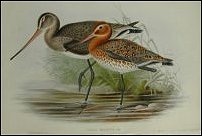 passing over the M56
and made our way along the banking to the Weaver Bend. The path was rather
overgrown and it would seem that perhaps this part of the marshes is not used
as much as it was in the past - the water level was higher than we remembered
it and there was no actual mud in view, although when we used to visit the area
in years gone by the level changed slightly during the day, so perhaps on
Tuesday we were a little unlucky. The only waders in view were Black-tailed
Godwits; super birds in a wide variety of plumages, with their long bills and
legs they found the water depth just to their liking and we had excellent,
extended views of a flock of around 120 birds. One particular bird that we took
to be a juvenile had two long coloured rings on the tibia of it's left leg, the
lower one was red and the upper pale blue, there are a number of ongoing
studies of this species, trying to work out who to inform is a nightmare - who would you contact? Also ringed was a
perching Cormorant, this bird wore an orange ring inscribed with the number 17
in white, again I've contacted the probable ringer and await any details that
may be available.
passing over the M56
and made our way along the banking to the Weaver Bend. The path was rather
overgrown and it would seem that perhaps this part of the marshes is not used
as much as it was in the past - the water level was higher than we remembered
it and there was no actual mud in view, although when we used to visit the area
in years gone by the level changed slightly during the day, so perhaps on
Tuesday we were a little unlucky. The only waders in view were Black-tailed
Godwits; super birds in a wide variety of plumages, with their long bills and
legs they found the water depth just to their liking and we had excellent,
extended views of a flock of around 120 birds. One particular bird that we took
to be a juvenile had two long coloured rings on the tibia of it's left leg, the
lower one was red and the upper pale blue, there are a number of ongoing
studies of this species, trying to work out who to inform is a nightmare - who would you contact? Also ringed was a
perching Cormorant, this bird wore an orange ring inscribed with the number 17
in white, again I've contacted the probable ringer and await any details that
may be available.
02/08/03 An overdue visit to Tatton [map] on Thursday (31st.), just the Knutsford end, the "top end" towards the Deer Park now resembles down town Baghdad as the site of the RHS Flower Show is cleared and reinstated. A pair of Dabchicks were feeding 2 small youngsters in the clear water between the towering ranks of phragmites reeds, whilst further up on the main mere I noted a single brood of 2 Tufted Ducks, I recall counting 12 broods in 1978 and no less than 20 in 1979 during fieldwork for the "Breeding Bird Atlas of Cheshire and Wirral" (incidentally, if you have a copy of this book, then hang on to it because it's becoming very collectable. You're looking at c £40 at the moment - and even more if you persuaded JPG to add his signature to those of the other 3 co-authors!) In warm sunny weather I walked further into the park and sat by the side of Tatton Mere, it was very quiet with little in the way of birds except moulting Canada Geese, Mallards etc. Initially there were no birds at all to be seen over the water but, after a few minutes, 3 Sand Martins appeared and spent 5 minutes or so hawking for insects close to the shore. Shortly afterwards they were replaced by a party of Swifts that arrived from the north, 5 birds at first, but over a period of 10 minutes they were joined by others until 40+ were racing up and down the length of the mere. These birds fed silently for about 5 minutes before they too gained height and drifted off towards the South - this was a good example of visible migration, a phenomena that is not always as clear-cut as these two examples, and more difficult and vague at inland locations than on the coast. I seem to remember an article on the subject in "Bird News", the Cheshire & Wirral Ornithological Societies excellent quarterly magazine, it dealt with visible migration in the Pennines. The Society (CAWOS) has, in the past, organised events in the Autumn to help people get stated in this field, and there is group dedicated to the subject on the Internet.
Our hard working Secretary, Roy, spent 2 hours at the travel agents earlier in the week and has booked the Odyssia Beach Hotel at Missiria, near Rethymnon for next May's 30th. anniversary trip to Crete - something to look forward to during those long Winter nights that lie ahead!!
26/07/03 Apologies for this late update, but we've had computer problems, now sorted out by our friendly local computer shop - ServiceSure on King Street in Knutsford - highly recommended! On Tuesday we enjoyed a stroll round the Anderton Reserve at Northwich - starting from the Northwich car park, followed on Friday by our final KOS Summer evening walk at the same location, this time meeting at the small car park near the Anderton lift. Work continues on this excellent Reserve, a bridge is shortly to be built across from the Northwich side of Witton Brook which will allow access from the town centre. Heavy rain on Friday had raised the water level, the Green Sandpiper we saw on Tuesday had moved to Haydyn Pool and the two Common Sandpipers that had accompanied it we found on an area of mud further upstream. In the phragmites reed all along the side of the River Weaver were Reed Warblers - stand still for a few moments and they'll appear - adults and their young - some song on Tuesday, but little on Friday except for a single bird with a full, but half speed delivery. There were more Warblers in the tangle of undergrowth along the river with Blackcaps and Willow Warblers still in song plus a Chiffchaff and a juvenile Common Whitethroat skulking in the shadows. Definitely not lurking out of sight two colourful species, at least 2 kingfishers - flashing cobalt blue as they moved up and down the river, no doubt taking full advantage of the profusion of small fry that we could see swimming just below the surface plus another splash of colour in the form of a Green Woodpecker that gave fleeting views on both days. From the hide overlooking Haydyn Pool we watched a motley collection of eclipse wildfowl - Mallard, Tufted Duck and Gadwall - overhead all three hirundines, including good numbers of Sand Martins, plus 4 Greylag Geese, whose annual moult would now appear to be over. We returned to the car park along the canal tow path, stopping en-route for one or two interesting looking flowers, including Gipsywort whose name I remembered after 12 months! and a Pied Wagtail roost of about 30 birds in the phragmites growing on the opposite side of the canal. Interesting news from Rostherne where Dave Clarke reports two unusual records for this time of the year. A Bittern was spotted in the reeds from the whiteley hide and a drake goldeneye in eclipse has been present since early July, this is probably a non-breeding bird moulting into full adult plumage.
17/07/03 A beautiful day on Sunday (13th. ) for our trip across mid-Wales to Lake Vyrnwy; on the map it looks to be a long drag, but in fact we arrived after a journey of only 1 hour 40 minutes via the M56/53, A5 and A495 - the final 10 miles a real pleasure along traffic free roads through some very attractive countryside. We turned left after driving over the impressive dam, and pulled into in the car park outside the small cafe (I think it's called "Kate's") where we relaxed for a few minutes over a cup of very reasonably priced coffee. There's an RSPB hide in the car park where we began our walk, on the feeders Chaffinches predominated, but also there using special feeders filled with seed, which was accessible via tiny holes, were Siskins - they were oblivious to the presence of observers behind the glass and could be watched from a distance of only a few inches! Out again into the fresh air and on up the hill at a slow birdwatcher's pace (the mercury was heading steadily up towards 30ºC) more Siskins overhead, plus family parties of hirundines and Swifts with the large black silhouettes of the days first Ravens, even higher in the sky passing over the valley. This year we didn't see any Wood Warblers or Pied Flycatchers, but we were luckier with Redstarts and the Spotted Flycatchers, which gave really good views on our way up to the top of the hill. For many though the most interesting birds of the morning were a family of Marsh Tits in the roadside birch trees, we just don't get them any more in the Knutsford area, not since a pair nested in Dog Wood during the early 80's, so it was nice to renew acquaintances and enjoy a good "discussion" about their identity!! Back at the cars we headed round the reservoir in a clock-wise direction parking at the far end by the side of the road to Bala, Jean and Sue had remembered a spot where we could enjoy a late lunch away from the flies that had caused annoyance in previous years. What a pleasant location it was - only about half a mile from the road, in a narrow valley next to an impressive waterfall about 80' high - we spent a couple of hours there, not too many birds although we did have Grey Wagtail, Redpoll and a fleeting glimpse of a Merlin racing over the mountain tops.
11/07/03 On Tuesday I paid a second visit
to the area around Black Brow Farm, near
the" Bay Malton" pub on the outskirts of Altrincham, this time though
with other members of the "Tuesday Club"
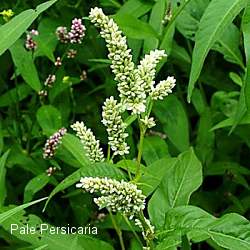 who are
very skilled in the art of plant identification (assuming of course you can
stop them talking about digital cameras, tripods, telescopes etc. long enough
to point them in the direction of the object requiring a name!) We set off from
a small car park about 50 yards past the "Bay Malton" and proceeded
in a westerly direction along the disused railway line that now forms part of
the trans-pennine trail; the most prominent bird species was Common Whitethroat
- there were examples of every stage in the breeding cycle, singing males,
adults carrying food, dropping down to hidden nests and the final product -
free flying youngsters! Yellowhammers were still in full song as were both Reed
and Corn Buntings; we heard one of the latter in song - at a distance - but got
really good views through Jill's telescope of 2 other birds, one of which was
carrying food. A lack of substantial perches meant the birds rested on stalks
of wheat growing in the field and before landing they hovered rather like
Skylarks, but with legs dangling, prior to dropping down out of sight. This
practice of flying with legs hanging loose is characteristic of this species,
but we never saw it with the birds we had in Mobberley - they flew in the
normal manner from fence posts and electricity cables, perhaps it's only when
they have to fly slowly, almost hovering, that it's most noticeable. Reaching
the first bridge,
who are
very skilled in the art of plant identification (assuming of course you can
stop them talking about digital cameras, tripods, telescopes etc. long enough
to point them in the direction of the object requiring a name!) We set off from
a small car park about 50 yards past the "Bay Malton" and proceeded
in a westerly direction along the disused railway line that now forms part of
the trans-pennine trail; the most prominent bird species was Common Whitethroat
- there were examples of every stage in the breeding cycle, singing males,
adults carrying food, dropping down to hidden nests and the final product -
free flying youngsters! Yellowhammers were still in full song as were both Reed
and Corn Buntings; we heard one of the latter in song - at a distance - but got
really good views through Jill's telescope of 2 other birds, one of which was
carrying food. A lack of substantial perches meant the birds rested on stalks
of wheat growing in the field and before landing they hovered rather like
Skylarks, but with legs dangling, prior to dropping down out of sight. This
practice of flying with legs hanging loose is characteristic of this species,
but we never saw it with the birds we had in Mobberley - they flew in the
normal manner from fence posts and electricity cables, perhaps it's only when
they have to fly slowly, almost hovering, that it's most noticeable. Reaching
the first bridge,
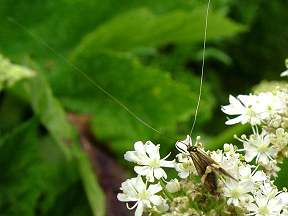 we turned right along the road
for a few yards, before taking the return route across the fields via the
Cheshire Wildlife Trust's Blackmoss Covert reserve. John had carried out some
enquiries and discovered that some of these fields belong to the
Countryside
Stewardship Scheme, others not - it was easy to differentiate between the
two. Those not part of the scheme were exclusively one crop, no
"weeds" and growing right up to the boundary whereas those in the
scheme had wide margins and a main crop containing a range of wildlife friendly
plants. Amongst other things our botanists identified Redshank, Mugwort, Common
Orache, Hedge Mustard, Field Forget-me-not, Wild Pansy, Rye Grass, Corn
Chamomile, Pineapple Mayweed, Common Wintercress, Pale Persicaria and Prickly
Sow-thistle in the field margins, whilst in amongst the Wheat were
Large-flowered Hemp-nettle and Wild Oats. So we're getting there slowly - if
it's got feathers, we can identify it : if it's growing in the soil we can
normally identify it : but there are some frustrating gaps in our knowledge -
what was the insect the Corn Bunting was carrying to its nest - what are all
the insects we see on the hogweed flower heads, like the fine specimen on the
left in John's photo? - perhaps we'll never know, but we can enjoy trying to
find out! - Happiness is the pursuit of knowledge (and perhaps a glass or two
of red wine).
we turned right along the road
for a few yards, before taking the return route across the fields via the
Cheshire Wildlife Trust's Blackmoss Covert reserve. John had carried out some
enquiries and discovered that some of these fields belong to the
Countryside
Stewardship Scheme, others not - it was easy to differentiate between the
two. Those not part of the scheme were exclusively one crop, no
"weeds" and growing right up to the boundary whereas those in the
scheme had wide margins and a main crop containing a range of wildlife friendly
plants. Amongst other things our botanists identified Redshank, Mugwort, Common
Orache, Hedge Mustard, Field Forget-me-not, Wild Pansy, Rye Grass, Corn
Chamomile, Pineapple Mayweed, Common Wintercress, Pale Persicaria and Prickly
Sow-thistle in the field margins, whilst in amongst the Wheat were
Large-flowered Hemp-nettle and Wild Oats. So we're getting there slowly - if
it's got feathers, we can identify it : if it's growing in the soil we can
normally identify it : but there are some frustrating gaps in our knowledge -
what was the insect the Corn Bunting was carrying to its nest - what are all
the insects we see on the hogweed flower heads, like the fine specimen on the
left in John's photo? - perhaps we'll never know, but we can enjoy trying to
find out! - Happiness is the pursuit of knowledge (and perhaps a glass or two
of red wine).
NB. "C and H" in Wilmslow, you requested an update e-mail - these are bouncing back - are your details correct?)
06/07/03 Bill
Mulligan always took his annual holidays in July, explaining to Mrs.
Mulligan that they would thus benefit from the lighter nights and additionally
miss the school holidays.
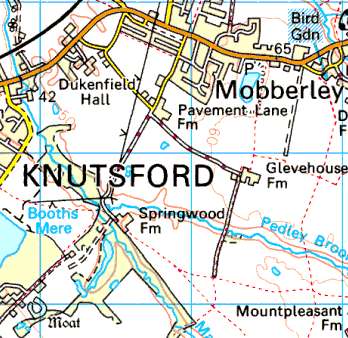 The real reason of
course was that July is considered by most to be the quietest month of the
ornithological year, so with Bill wishing to minimise the chances of missing
anything rare, that was when the Mulligans went away, (and why today many
birdwatchers develop a sudden annual interest in flowers and insects at this
time of year!) During the 1980's, when we were doing fieldwork for the Cheshire
breeding bird atlas, we found that July was often very productive because it
was then possible to watch adult birds feeding their young, so confirming the
breeding of some species that are difficult earlier in the season due to their
secretive nature around the nest site. We noted evidence of breeding success
today on a circular walk round that area of Mobberley known locally as
"Fox Harbour" - past Pavement Lane Farm on the way down to Springwood
Farm, through the farmyard and then along the public footpaths to Pedley Brook,
before heading back via the track running through the farmyard at Gleavehouse.
Flocks of up to 40 House Sparrows were causing a commotion in the hedges close
to the farms, whilst overhead House Martins and Swallows were present in good
numbers, with the adults feeding their young on the wing, pausing only briefly
as a Sparrowhawk passed by on it's way into Spring Wood - it was carrying prey.
Moving into the wood we heard a surprising number of species in song including
Dunnock, Wren, Stock Dove, Blackcap and Chiffchaff : on an overhanging Willow
branch, standing almost side by side, a Kingfisher and a Heron (side by side
but not shoulder to shoulder!) - talking to the water bailiff, it appears that
a pair of Herons attempted to nest this year in Spring Wood, although they were
unsuccessful. Away from the farm buildings and into the fields a Reed Bunting
was still singing from a marl pit where a Moorhen was feeding a single small
young bird - perhaps the product of a repeat or second clutch. There were
plenty of Finches about, Chaffinches around the farmyard at Gleavehouse, an
encouraging number of Linnets including a fine male bird in song at the same
location, and four male Yellowhammers in song - they have a long breeding
season - I once flushed an incubating bird from a nest in August, it contained
4 eggs - all pure white!
The real reason of
course was that July is considered by most to be the quietest month of the
ornithological year, so with Bill wishing to minimise the chances of missing
anything rare, that was when the Mulligans went away, (and why today many
birdwatchers develop a sudden annual interest in flowers and insects at this
time of year!) During the 1980's, when we were doing fieldwork for the Cheshire
breeding bird atlas, we found that July was often very productive because it
was then possible to watch adult birds feeding their young, so confirming the
breeding of some species that are difficult earlier in the season due to their
secretive nature around the nest site. We noted evidence of breeding success
today on a circular walk round that area of Mobberley known locally as
"Fox Harbour" - past Pavement Lane Farm on the way down to Springwood
Farm, through the farmyard and then along the public footpaths to Pedley Brook,
before heading back via the track running through the farmyard at Gleavehouse.
Flocks of up to 40 House Sparrows were causing a commotion in the hedges close
to the farms, whilst overhead House Martins and Swallows were present in good
numbers, with the adults feeding their young on the wing, pausing only briefly
as a Sparrowhawk passed by on it's way into Spring Wood - it was carrying prey.
Moving into the wood we heard a surprising number of species in song including
Dunnock, Wren, Stock Dove, Blackcap and Chiffchaff : on an overhanging Willow
branch, standing almost side by side, a Kingfisher and a Heron (side by side
but not shoulder to shoulder!) - talking to the water bailiff, it appears that
a pair of Herons attempted to nest this year in Spring Wood, although they were
unsuccessful. Away from the farm buildings and into the fields a Reed Bunting
was still singing from a marl pit where a Moorhen was feeding a single small
young bird - perhaps the product of a repeat or second clutch. There were
plenty of Finches about, Chaffinches around the farmyard at Gleavehouse, an
encouraging number of Linnets including a fine male bird in song at the same
location, and four male Yellowhammers in song - they have a long breeding
season - I once flushed an incubating bird from a nest in August, it contained
4 eggs - all pure white!
30/06/03 Atrocious weather on Friday (27th.) in the afternoon before our evening trip to the Goyt Valley, although as we left Knutsford the rain had stopped, and over to the west the sky was becoming brighter as the dryer weather promised by the met. office approached. Visibility over the hills was very poor as we drove up out of Macclesfield, but improved considerably as we dropped down to our final destination in the valley on the shores of the Errwood Reservoir. Most of the species we saw had young, some like the Pied and Spotted flycatchers were carrying food, others such as the Redstart we had such good views of, weren't too happy with our intrusion as we passed, so it was a fair assumption that they too had successfully bred. Most song had ceased but a single Willow Warbler was heard, together with at least 3 Tree Pipits which were very active and gave excellent views as they perched at the top of the roadside conifers. We left the wooded area (leaving behind some ferocious little midges!) and headed further up the valley towards Derbyshire Bridge, on the way - in fading light - a distant family party of passerines was the subject of some discussion, they were either Stonechats or, more probably given the location, Whinchats. Above in the heather we had intermittent views of Red Grouse plus a Short-eared Owl, which was quite a pleasant surprise and an excellent end to a rewarding evening up in the Pennines.
26/06/03 In
his book "The birds of Cheshire" published in 1962 Hedley Bell
described the Corn Bunting as having a very restricted distribution in
Cheshire, with strongholds in the Mersey marshes and the lower Weaver valley
but regularly adhering to certain restricted localities.
 Even earlier, in
1910, Coward reported a similar situation plus
an "invasion into the tract of cultivated land which has replaced
Carrington Moss"; by the time we began taking a serious interest in
birdwatching, in the early 1970's, Corn Buntings had become much more
widespread and were nesting in good numbers around Knutsford and Mobberley.
That period appears to have been their high point and since then numbers have
declined considerably; I haven't seen a singing male locally for some years, a
phenomena seen right across the Country. It's not all doom and gloom though,
Terry Atkinson mentioned hearing Corn Buntings in song around the "Axe
& Cleaver" , a pub in Dunham, and an area where Nigel Troupe had noted
Wintering birds last December, bordering Carrington Moss, their stronghold in
Coward's day! I paid a visit to the area on Monday evening (23rd.) driving
towards the Altrincham Crematorium from the A556, but turning just before the
Crem. down Black Moss Road before parking a couple of hundred yards past Black
Brow Farm. The whole area is very flat, with scattered woodland and low
treeless hedges. The fields contained cereals or grass - a farmer was mowing
one of the latter as I watched, wrapping it into those huge black plastic bags
for silage. Wheat appeared to be the main cereal being grown, but the fields
weren't ordered and restricted to one species, wild grasses and thistles were
present in amongst the wheat and had taken over the extra wide field margins
completely. I'm not too good on flowers, but I did notice a lot of Redshank
(Polygonum persicaria) and Mugwort (Artemisia vulgaris) growing
round the perimeter, these two will both provide seed for overwintering birds:
I suspect this area is being deliberately farmed with wildlife in mind, perhaps
part of the
Countryside
Stewardship Scheme, John Somerville has some contacts in the area and is
going to check. The birds seemed to be prospering, I flushed a covey of Grey
Partridges, family parties of Linnets were very active in the boundary hedges
and I even watched a Yellow Wagtail collecting food, before flying off towards
Carrington Moss. Finally to the object of the visit - Corn Buntings, and yes
there they were! I spent only about half an hour in the area and only watched
from one location but had 3 individuals, one bird was in full song about a
quarter of a mile to the north, a second bird wasn't happy with my presence so
I assume it had a nest, perhaps with young. It spent some time chasing a third
bird from the area each time it approached, so I suppose this wasn't it's mate,
perhaps an unattached male. This is a splendid area and well worth a longer
visit, I see from the map that a disused railway crosses the fields, this could
perhaps be used as part of a circular walk - perhaps a job for the Tuesday
group!
Even earlier, in
1910, Coward reported a similar situation plus
an "invasion into the tract of cultivated land which has replaced
Carrington Moss"; by the time we began taking a serious interest in
birdwatching, in the early 1970's, Corn Buntings had become much more
widespread and were nesting in good numbers around Knutsford and Mobberley.
That period appears to have been their high point and since then numbers have
declined considerably; I haven't seen a singing male locally for some years, a
phenomena seen right across the Country. It's not all doom and gloom though,
Terry Atkinson mentioned hearing Corn Buntings in song around the "Axe
& Cleaver" , a pub in Dunham, and an area where Nigel Troupe had noted
Wintering birds last December, bordering Carrington Moss, their stronghold in
Coward's day! I paid a visit to the area on Monday evening (23rd.) driving
towards the Altrincham Crematorium from the A556, but turning just before the
Crem. down Black Moss Road before parking a couple of hundred yards past Black
Brow Farm. The whole area is very flat, with scattered woodland and low
treeless hedges. The fields contained cereals or grass - a farmer was mowing
one of the latter as I watched, wrapping it into those huge black plastic bags
for silage. Wheat appeared to be the main cereal being grown, but the fields
weren't ordered and restricted to one species, wild grasses and thistles were
present in amongst the wheat and had taken over the extra wide field margins
completely. I'm not too good on flowers, but I did notice a lot of Redshank
(Polygonum persicaria) and Mugwort (Artemisia vulgaris) growing
round the perimeter, these two will both provide seed for overwintering birds:
I suspect this area is being deliberately farmed with wildlife in mind, perhaps
part of the
Countryside
Stewardship Scheme, John Somerville has some contacts in the area and is
going to check. The birds seemed to be prospering, I flushed a covey of Grey
Partridges, family parties of Linnets were very active in the boundary hedges
and I even watched a Yellow Wagtail collecting food, before flying off towards
Carrington Moss. Finally to the object of the visit - Corn Buntings, and yes
there they were! I spent only about half an hour in the area and only watched
from one location but had 3 individuals, one bird was in full song about a
quarter of a mile to the north, a second bird wasn't happy with my presence so
I assume it had a nest, perhaps with young. It spent some time chasing a third
bird from the area each time it approached, so I suppose this wasn't it's mate,
perhaps an unattached male. This is a splendid area and well worth a longer
visit, I see from the map that a disused railway crosses the fields, this could
perhaps be used as part of a circular walk - perhaps a job for the Tuesday
group!
***** Please note - the usual meeting point for field
trips, the Sessions House on Toft Road is being renovated and the carpark is
unavailable - so until further notice all trips will start from the Dog Lodge
Lay-by, on Mobberley Road ****
19/06/03 A good turnout on Sunday for our
field trip to Leighton Moss, 19 members travelled up the M6 on what was the
hottest day of the year so far, with the temperature reaching 28ºC. Of the
Reserve's specialities only the Marsh Harriers were showing well, with
excellent views of both male and female birds floating over the reedbeds,
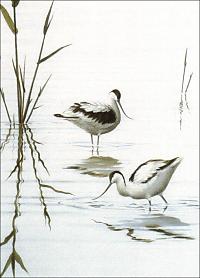 Bittern numbers were
still low - only 3 birds, and there was neither sight nor sound of them, or of
the 20 or so Bearded Tits present on the Reserve. Reed and Sedge Warblers were
both still singing from the reeds, together with Reed Buntings and Wrens. More
song from our Summer visitors as we walked the circular route past the public
hides, along the path at the far side of the Reserve, returning along the road
to the information centre; Single Spotted Flycatchers, Blackcaps and
Chiffchaffs were heard, plus numerous Willow Warblers in the shrubbery between
the reeds and the surrounding farmland. Overhead we heard the call of a Raven
and, moving from undercover into a clearing, we could see 7 birds soaring high
over the hills to the south, perhaps a family party, Ravens are early nesters
and can be found on eggs in February or even late January. We made our way
across to the Allen and Eric Morecambe hides, overlooking Morecambe Bay for the
high tide - Oystercatchers, Redshanks and Ringed Plovers were all present, plus
increasing numbers of Black-tailed Godwits. Pride of place though amongst the
waders must go to the Avocets, now well established on the Reserve, with a
maximum of 21 birds counted recently. This year 8 pairs nested and 15 eggs
hatched, but only 3 of the young survived a spell of wet, cold conditions in
May, although one pair seem to have laid a replacement clutch and were
incubating eggs on an island in the middle of Allens Pool. I found this
excellent
website whilst looking for further details about the Avocets, it appears to
be updated on a daily basis by a real enthusiast! As we watched this scene of
peace and tranquility there was a sudden flurry of activity as 100's of birds
took to the air simultaneously - they had every reason to be concerned! Through
the middle of them, in hot pursuit of a Godwit appeared a Peregrine Falcon, we
picked it up about a quarter of a mile away, but such was it's speed that
within a few seconds it had vanished over the roof of the hide. I believe two
of the three "newcomers" in the party had reasonable views of the
Peregrine - it's not a rare species, but we don't often get to see them hunting
in such a spectacular manner, that sort of image can remain with you for a
long, long time!
Bittern numbers were
still low - only 3 birds, and there was neither sight nor sound of them, or of
the 20 or so Bearded Tits present on the Reserve. Reed and Sedge Warblers were
both still singing from the reeds, together with Reed Buntings and Wrens. More
song from our Summer visitors as we walked the circular route past the public
hides, along the path at the far side of the Reserve, returning along the road
to the information centre; Single Spotted Flycatchers, Blackcaps and
Chiffchaffs were heard, plus numerous Willow Warblers in the shrubbery between
the reeds and the surrounding farmland. Overhead we heard the call of a Raven
and, moving from undercover into a clearing, we could see 7 birds soaring high
over the hills to the south, perhaps a family party, Ravens are early nesters
and can be found on eggs in February or even late January. We made our way
across to the Allen and Eric Morecambe hides, overlooking Morecambe Bay for the
high tide - Oystercatchers, Redshanks and Ringed Plovers were all present, plus
increasing numbers of Black-tailed Godwits. Pride of place though amongst the
waders must go to the Avocets, now well established on the Reserve, with a
maximum of 21 birds counted recently. This year 8 pairs nested and 15 eggs
hatched, but only 3 of the young survived a spell of wet, cold conditions in
May, although one pair seem to have laid a replacement clutch and were
incubating eggs on an island in the middle of Allens Pool. I found this
excellent
website whilst looking for further details about the Avocets, it appears to
be updated on a daily basis by a real enthusiast! As we watched this scene of
peace and tranquility there was a sudden flurry of activity as 100's of birds
took to the air simultaneously - they had every reason to be concerned! Through
the middle of them, in hot pursuit of a Godwit appeared a Peregrine Falcon, we
picked it up about a quarter of a mile away, but such was it's speed that
within a few seconds it had vanished over the roof of the hide. I believe two
of the three "newcomers" in the party had reasonable views of the
Peregrine - it's not a rare species, but we don't often get to see them hunting
in such a spectacular manner, that sort of image can remain with you for a
long, long time!
13/06/03 Only a week to go until the longest day, then it's downhill all the way to Christmas! A Hobby today, cruising over Town Lane in Mobberley, following a sighting earlier in the week by Paul Leigh over Spring Wood. A Lesser Whitethroat has been singing all week from the tall hawthorn hedge along Pavement Lane in Mobberley, perhaps a second brood on the way - a bird was singing at the same location this time last year. Evidence of breeding success for some of our more common species with family parties locally of House Sparrow, Starling, Blue and Great Tits, a male Great Spotted Woodpecker with a youngster in tow found rich pickings in one of the well manicured gardens along Lilac Avenue in Knutsford, whilst just down the road along Sudlow Lane the Yellow Wagtails we saw last week have been seen carrying food - very encouraging. The Tuesday group had a respectable total of 45 species during a pleasant walk round the Anderton Reserve in Northwich including Reed, Sedge and singing Grasshopper warbler, Birds seen with young included Shelduck, Oystercatcher, Dabchick, Gadwall and Lapwing - these young Lapwings have done well, the heavy rain we suffered a couple of weeks ago won't have helped ground nesters at a critical time of the year. Also seen on Haydyn Pool was a Green Sandpiper - numbers of this species start to increase during June as female birds begin to return from their breeding areas. They spend only a few weeks in the north, assisting with incubation, but leaving the male to look after the chicks shortly after hatching.
06/06/03We had two options on Tuesday - (a)
Fight our way through the rush hour traffic in Macclesfield and travel, as
planned, for a second look at the Goyt Valley or (b) Have a quick blast down
the A55 to the RSPB Reserve at South Stack on Anglesey and join the 100's of
other birders jostling for a view of the latest * MEGA TICK * - a Black Lark
(Melanocorypha yeltoniensis) a partial migrant from around the Caspian
Sea in Kazakhstan and a first for Britain.
The choice was pretty obvious! and despite a less than encouraging weather
forecast we had super views across the Cheshire Plain from Pym Chair as we
began the steep descent down to the Goyt, parking in the first car park on the
right hand side opposite the road across the dam. Except for the Tree Pipit
last weeks birds were still in song and we were able to watch Redstarts, Wood
Warblers, Pied and Spotted Flycatchers for extended periods at really close
quarters. As if by way of compensation for missing the Tree Pipit, on the way
up the valley towards Derbyshire Bridge, we stopped in a lay-by and were
delighted to hear the short but characteristic song of a Whinchat. It's hard to believe that in
1922 Abbott counted 36 territorial males in 22 square kilometers around
Wilmslow!
Last night (5th) Derek and I enjoyed a short visit to fields alongside Sudlow
Lane in Knutsford, just before the motorway bridge; it's noisy, only 400 yards
from the M6, but the birds remain unaffected. Over towards the east we could
see Toft Hall Farm where Pete Hall reports that a pair of Oystercatchers have
hatched young, making two successful pairs in the area this Spring. This
species is new as a confirmed breeder over the past few years. The Sudlow Lane
fields we walked were lying fallow or contained Potatoes or Maize, some quality
birds were present including Lapwings with young, a pair of Yellowhammers,
small numbers of Tree Sparrows, four singing Skylarks and, best of all, two
Yellow Wagtails - I was wondering if I was going to see a single example in
Cheshire this year. How many of those who made the journey to Anglesey will
finish the year with more Black Larks on their tick lists than Yellow
Wagtails?
01/06/03Warm and sunny on Friday (30th) for
the first evening walk of the Summer when a party of 14 members travelled
across to Macclesfield and on up to
Wildboarclough for a gentle stroll around a circuit of about 2 miles,
stating and ending at the picturesque Crag Inn. Predictably there wasn't too
much activity on the top road above the tree line, but lower down on Clough
Brook we had excellent views of a pair of colourful Grey Wagtails and a very
confiding Dipper, all watched at close range from the roadside. The pub had
some very acceptable bitter on hand pumps, which we enjoyed in the gardens, as
the sun set over
Shutlingsloe, very civilised!
Earlier in the week I'd paid an annual pilgrimage to the
Goyt
Valley, not too far from Wildboarclough, just the other side of the
"Cat and Fiddle". It's here we can normally see 5 species that
occasionally turn up in the Knutsford area, but not on a regular basis.
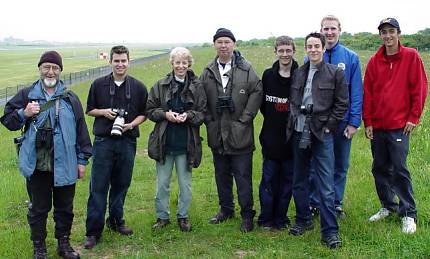 The first of these
was a Tree Pipit singing from an oak tree on the side of the Errwood Reservoir,
just past the car park at the northern end of the lake. More of these
specialities quickly followed with singing Wood Warbler (3), Redstart (4) and
Pied Flycatcher (3) followed by an elusive Spotted Flycatcher: now quite rare
in our area. Also seen / heard Chiffchaff, Willow Warbler, Blackcap, Cuckoo,
Grey Wagtail, Common Sandpiper and 2 overflying Siskins - go now before these
birds stop singing - it's a lot easier than later on in the season!
The first of these
was a Tree Pipit singing from an oak tree on the side of the Errwood Reservoir,
just past the car park at the northern end of the lake. More of these
specialities quickly followed with singing Wood Warbler (3), Redstart (4) and
Pied Flycatcher (3) followed by an elusive Spotted Flycatcher: now quite rare
in our area. Also seen / heard Chiffchaff, Willow Warbler, Blackcap, Cuckoo,
Grey Wagtail, Common Sandpiper and 2 overflying Siskins - go now before these
birds stop singing - it's a lot easier than later on in the season!
Back on the Cheshire Plain, last Tuesday (27th.) we did our first
circumnavigation this year of Manchester Airport's runway 2 footpaths - it's
always good value, the whole area surrounding the runway has been designed with
wildlife in mind with a number of attractive ponds, wet meadow land and dense
areas of shrubbery that are proving very attractive to a growing number of
species. Even when the birding is a little on the quiet side, there's always
plenty of activity elsewhere of interest, the airport is not an ideal
neighbour, but we all have to admit that the sight of a fully-laden Boeing 747
slowly lifting off and clawing it's way into the air is pretty impressive! For
some people it's a hobby - or more, John's picture shows 3 KOS Coffin Dodgers
with 5 planespotters we met on our way round, 2nd. from the left is one
Christopher P. Kilroy from Louisville Kentucky who runs a nice website for aircraft
photographers and seems to be doing quite well judging by the quality of his
photo gear - all digital, he claimed never to have used film! Things though did
become a little heated when one of our party pointed out rather forcibly that
70 aircraft movements an hour may impress some - but not those living on the
flightpath! but it all ended amicably and we left them with the thought that in
another existence and with the help of a few more IQ points they could well
have become birdwatchers!!! We recorded a total of 39 species including Grey
Wagtail, Common & Lesser Whitethroat plus good numbers of Tree Sparrow and
Reed Bunting, Blackcap, Chiffchaff and 9 singing Willow Warblers.
26/05/03 Under the auspices of the
Countryside
Stewardship Scheme (CSS) participating farmers are paid to alter their
farming practices to "improve the natural beauty of the countryside".
Sugar Brook Farm, on the main road between Mobberley and Ashley (SJ775830) is
one of a number of Cheshire farms participating. John Irlam, the tenant farmer,
has kindly given us permission to wander round as and when we want, so as time
passes it will be interesting to monitor the bird populations - both Winter and
Summer. A survey was carried out by a volunteer working for the RSPB in the
Summer of 2000, and a very nice distribution map produced, this can be used as
a benchmark. I paid my first visit last week and recorded 39 species in a 3
hour tramp round the perimeter; not a bad total but we'll no doubt bump that up
to 50+ Summer species without too much trouble. There was no sign of the Tree
Sparrows and Yellowhammers that were recorded in the 2000 survey, but, of
course, it's precisely because of the decline in these two species, along with
a few others, that this scheme was set up in the first place. A Buzzard had
nested in an ivy-covered Ash tree less than 100 yards from the farm and both
Kestrel and Sparrowhawk were seen hunting over the large area of reeds that are
flourishing in one particular area where the land drains have been blocked as
part of the scheme.
One less species today (38) when I joined Derek and Sheila for the
BTO Breeding Bird Survey on a
1km. square in Marthall, near Chelford. Within the survey area lie a couple of
working farms plus a scattering of houses, and it was in the gardens of the
houses that we found the largest variety of species - the farmland itself is
given over to acres of wheat and barley in fields bounded by low well-trimmed
hawthorn hedges - not an attractive environment for many species. Isolated
pairs of Yellowhammers and Linnets were clinging on - but no sign of Yellow
Wagtails, Corn Buntings or even a single Skylark in a part of the County where
they would have been found in abundance 20 years ago.
Bob Groom has supplied the only record of Yellow Wagtail seen in our local area
this Spring - a bird at Tatton on the 18th. of April, 3 days later he noted a
Common Tern at Rostherne with a second bird yesterday (25th.) at Budworth Mere.
On a more upbeat note, the Grey Wagtail seems to be doing rather well nowadays,
Pete Hall reports a pair feeding young in the yard at Toft Hall Farm and I've
watched a nesting pair for a few weeks now on the redundant main building at
the Ilford factory in Mobberley.
20/04/03The Lesser Whitethroat is still
singing by "crash gate 9" at the end of Lady Lane in Mobberley; we
had intended to begin our Tuesday morning ramble there this morning, before
doing our first Runway 2 circuit of the year, but the weather was just too bad
so we chose instead to spend a couple of hours at the Rostherne Reserve.
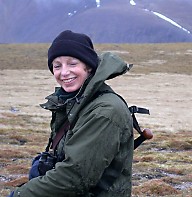 It was
predictably quiet, Swifts and House Martins were keeping low over the Mere
in-between frequent heavy showers, at one point a Cuckoo passed through the
middle of them, in search of Reed Warblers nests no doubt. From the Observatory
we were too far away to hear these or the Sedge Warblers that Dave Clarke, one
of the Reserve Wardens mentioned in a recent e-mail update. Welcome back to
Jill and Sheila recently returned from two decidedly different locations.
Sheila had headed north, accompanied by Len Mason, to Speyside where they met
up with our old friend from "Operation Osprey" days, Dave Pullan.
They all had good views of displaying Red-throated Divers and Slav. Grebes,
whilst Dave and Sheila were rewarded with
It was
predictably quiet, Swifts and House Martins were keeping low over the Mere
in-between frequent heavy showers, at one point a Cuckoo passed through the
middle of them, in search of Reed Warblers nests no doubt. From the Observatory
we were too far away to hear these or the Sedge Warblers that Dave Clarke, one
of the Reserve Wardens mentioned in a recent e-mail update. Welcome back to
Jill and Sheila recently returned from two decidedly different locations.
Sheila had headed north, accompanied by Len Mason, to Speyside where they met
up with our old friend from "Operation Osprey" days, Dave Pullan.
They all had good views of displaying Red-throated Divers and Slav. Grebes,
whilst Dave and Sheila were rewarded with
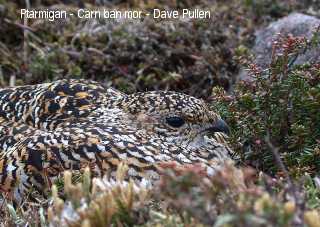 Dotterel and
Ptarmigan after a slog up Carn ban mor in drifting mist and horizontal snow.
Wisely Len chose to attack the "top Shelf" in a local hostelry rather
than subject himself two hours of self-inflicted pain on that tortuous ascent
that anyone who's ever been up there will remember so well!
Dotterel and
Ptarmigan after a slog up Carn ban mor in drifting mist and horizontal snow.
Wisely Len chose to attack the "top Shelf" in a local hostelry rather
than subject himself two hours of self-inflicted pain on that tortuous ascent
that anyone who's ever been up there will remember so well!
In complete contrast Jill and Roger enjoyed two weeks of unbroken sunshine
during what has become their annual Spring visit to Lesvos. They have seem
acquired a lot of local knowledge which allows them to enjoy all the Islands
specialities in relative peace and quiet away from the well publicised hot
spots! Jill's pictures taken with a digital camera hooked up to a quality
telescope (digiscoping) are superb and we're going to put some up on this
website shortly - you'll be well impressed!
18 members enjoyed last weekends visit to Suffolk - as I wasn't amongst them
here's Sheila's summary e-mailed tonight ( some editing by me to protect the
innocent!!)
Everyone did their own thing on the 2 travelling days, which included:
Weeting Heath: where a pair Woodlark showed well in front of the hide,
but only 1 pair of Stone Curlew was visible, and then usually just 1 adult. Of
the other 3 pairs there, 1 pair had had their young predated, another pair
nested out of sight of the hides, and the 3rd hadn't ‘got down to the
business’ – the male was willing but the female didn't want to know
apparently!
Lackford Reserve: Highlights included a pair of Hobbies, a very
wild-looking Egyptian Goose(!), very vocal Green Woodpecker, with a Tawny Owl
perched in the same Oak tree giving clear views.
Friday – everyone went to Minsmere Highlights: at least 2 Hobbies
hawking over the reed-beds, 2-3 Marsh Harriers showing well, a Bittern making
an incredibly prolonged flight around the reserve and then landing in the open
before realising that he was meant to be a skulking bird and promptly
disappeared into the reeds, some of the best views of Bearded Tits ever
carrying food to young in a nest close to the path, 2 Little Terns and both
Muntjac and Roe Deer seen. Many pairs of Avocets breeding on the islands but
all were still on eggs, whereas those up in the NW have fledged young.
Before I forget - Derek and Len each bought new lightweight birding coats!
(see 15/04/03 - Tony)
Saturday – A group of us went to Sizewell first, but no sign of any
Black Redstarts, but plenty of young Stonechat, and Kittiwakes breeding on the
platforms offshore.
Then on to Dunwich Heath - eventually good views of 2-3 Dartford
Warblers in the same area as 3 years ago, with Lesser Whitethroat close by (by
the toilet block) (I hope you didn't flush it - Tony!), plus a pair of
Marsh Harriers as an unexpected bonus over nearby reed-beds.
Finally on to Walberswick which was incredibly quite and no anticipated
Turtle Doves. A few Nightingales heard and occasionally glimpsed from various
sites visited, though not in the numbers we expected, same goes for
Cetti’s Warbler, good views of both Reed (more numerous) and Sedge
Warblers, Garden Warblers were common, with fewer Blackcaps seen and heard.
Only single Spotted Flys and Redstarts seen and no Pied Flys. Hirrundine
numbers low. Overall the numbers of birds were well down.
Geoff and I tried for Nightjars on the last night with no success (perhaps a
little early in the season). That’s it I think. In total the group clocked
up exactly 100 species seen, plus Water Rail heard. The wine flowed, the local
karaoke was checked out (‘Born to be Wild’ favourite), different
restaurants given our custom each night (well we couldn't go back to the same
place twice) and good birding to boot. Ain’t life grand!
15/04/03 In the good old days when our MP was the redoubtable Lt. Col. Sir Walter Bromley-Davenport, we lived in the Knutsford Parliamentary constituency, after some boundary changes the name Knutsford was dropped and it was renamed Tatton. We awoke yesterday morning to find that we're now officially the most affluent people in the whole of Britain I don't know where they collected their data from although I suspect it must have been along the Lilac Avenue / Clamhunger Lane corridor, rather than the Town Lane / Bucklow Avenue / Longridge triangle!!!
14/05/03 We finally located the nest hole of the Kingfishers that had been seen carrying food from the bottom end of Tatton Mere; they had select a remarkable site under an overhanging bank on the side of the main mere itself. In mid-week we watched from a distance as both birds delivered food to the nest, but there has been no sign of them since Friday - unfortunately the site was just a few yards from the concrete jetty which was crowded with boaters over the weekend and it's probable that the birds couldn't deal with that level of disturbance and have deserted. There's a possibility that the young have fledged, but that's unlikely, they would have had to have been laying eggs in March. Yesterdays strong winds caused a huge build up of hirundines and Swifts, an estimated 400 of the latter were milling around low over the mere at 7:00pm last evening. Earlier in the day it was a similar story at Budworth Mere, only this time the hirundines outnumbered the Swifts, it wouldn't have been a surprise to have seen a few windblown Terns given the conditions, but there were none - I still haven't seen an inland Tern this year. In the big wood we had good views of a Garden Warbler in full song and a pair of Treecreepers feeding young in a nest hidden behind the loose bark of an old oak tree - a classic site. We didn't come across the singing male Pied Flycatcher that we'd hoped to see, but it was there, a couple of birders we met later at Neumann's Flash had watched it at a location we'd not visited. Perhaps we should ask next time! At Neumann's a couple of Summer plumaged Dunlin had dropped in on their journey north and we counted 3 Little Ringed Plovers that are probably nesting somewhere out on the flash. The two LRPs at Mobberley SQ remained for a week or so before moving on.
08/05/03 Over the holiday weekend Jean
& Derek chose to do their birding in Tatton at the north end, overlooking
the deer park, they saw no less than 6 Wheatears, including at one stage, a
view of 5 at the same time. Interestingly one bird was exploring a sandy area
close to some rabbit burrows, this was the second occasion they had seen such
activity at that particular location, there's always a possibility that a pair
could remain to breed, it's ideal country. I read on the Internet that last
weekend Minsmere
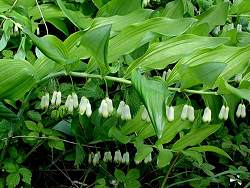 attracted so many visitors that all the car parks were full, people
were queuing to get in the hides and tempers became frayed as they struggled to
catch a glimpse of some semi-rarity to add to their year total! In complete
contrast we were on our own all Tuesday morning when we travelled north to the
Woolston Eyes Reserve,
the only sound came from the distant M6 where it passes over the Thelwall
Viaduct and the incessant clamour of the Black-headed Gulls enforcing a no-fly
zone over their nests scattered right across the Reserve. Some interesting
flowers had come into bloom, including the attractive Solomon's-seal
(Polygonatum odoratum) shown here in
John's digital photo. Reed and
Sedge Warblers were both singing in the reeds with Chiffchaff, Willow Warbler,
Blackcap and Common Whitethroats in song from the drier areas. On the water we
noted Tufted Duck, Shoveller, Gadwall, Pochard and 6 individual Black-necked
Grebes, these seem to be down in numbers this year. Overhead we had excellent
views of 2 Cuckoos chasing each other, my first of the year.
attracted so many visitors that all the car parks were full, people
were queuing to get in the hides and tempers became frayed as they struggled to
catch a glimpse of some semi-rarity to add to their year total! In complete
contrast we were on our own all Tuesday morning when we travelled north to the
Woolston Eyes Reserve,
the only sound came from the distant M6 where it passes over the Thelwall
Viaduct and the incessant clamour of the Black-headed Gulls enforcing a no-fly
zone over their nests scattered right across the Reserve. Some interesting
flowers had come into bloom, including the attractive Solomon's-seal
(Polygonatum odoratum) shown here in
John's digital photo. Reed and
Sedge Warblers were both singing in the reeds with Chiffchaff, Willow Warbler,
Blackcap and Common Whitethroats in song from the drier areas. On the water we
noted Tufted Duck, Shoveller, Gadwall, Pochard and 6 individual Black-necked
Grebes, these seem to be down in numbers this year. Overhead we had excellent
views of 2 Cuckoos chasing each other, my first of the year.
02/05/03 It's never easy to tell the difference between the songs of the Blackcap and Garden Warbler, so when confirming the identities of the first birds of the year it's always preferable if you can get a good look at the originator! Not always easy with the Garden Warbler, they spend a lot of time hidden away, but will eventually oblige and move out of cover into full view - allowing another tick to be appended to the note book. We had our first on Tuesday (29th) on Knutsford Moor, last night there were 3 singing males, showing well in the tangle of brambles, just over the bridge from Mallard Close. Further into Dog Wood, looking across to the Herons nest, it was clear that the 2 youngsters (scruffy, loud, unkempt individuals - nicknamed Frank and Len [rather unkindly I thought] by Derek Pike) are prospering with lots of wing flapping going on; it won't be long before they're on their way. There will be Herons everywhere; the Heronry at Budworth Mere is now possibly the largest in the Country. Over the main Mere we noted around 50 Swifts, yesterday Pete Hall had a flock of 100 over Toft ahead of an approaching rain storm. Later, on Tuesday evening, Roger Barnes had a shock as he approached Swan Clump at the far end of Tatton, towards the Mill Pond when a large raptor flew from one of the pine trees, it was chestnut in colour and had what appeared to be a white rump - it was a Harris Hawk; an American bird much favoured by falconers, which no doubt is where it originated.
25/04/03Some much needed rain over the past
24 hours, quite heavy and persistent at times, but it's done nothing to slow
the stream of Summer migrants flooding into the area.
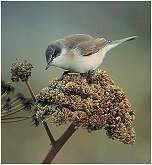 Yesterday (24th.) the first
Lesser Whitethroat of the year was singing from a hawthorn hedge at the end of
Lady Lane in Mobberley, just before the airport "crash gate",
excellent views were enjoyed, down to a few feet at times, as the dainty little
songster performed it's full Spring
repertoire. Heading towards Tatton this afternoon I was delighted to see a
Hobby powering across the sky over the Shaw Heath / Longridge area of the town;
like most other birds of prey it's increasing in numbers year on year and there
are probably more pairs nesting in Cheshire than most people realise! In Tatton
the weather conditions conditions were leading to a build up of hirundines,
flying with them, low over the Mere, Swifts - the first of the year - about 20
individuals.
Yesterday (24th.) the first
Lesser Whitethroat of the year was singing from a hawthorn hedge at the end of
Lady Lane in Mobberley, just before the airport "crash gate",
excellent views were enjoyed, down to a few feet at times, as the dainty little
songster performed it's full Spring
repertoire. Heading towards Tatton this afternoon I was delighted to see a
Hobby powering across the sky over the Shaw Heath / Longridge area of the town;
like most other birds of prey it's increasing in numbers year on year and there
are probably more pairs nesting in Cheshire than most people realise! In Tatton
the weather conditions conditions were leading to a build up of hirundines,
flying with them, low over the Mere, Swifts - the first of the year - about 20
individuals.
 23/04/03 The cooler temperatures and high winds over
the Easter weekend meant there was little of note on and over Llandudno's Great
Orme during a few days break during the holiday period. However down at sea
level, on the RSPB's Conway Reserve, there was much more activity - Redshanks,
Curlews and summer plumaged Black - tailed Godwits were sitting out the high
tide, whilst from the reed beds came the unmistakable song of newly arrived
Sedge Warblers; I counted 6 singing males. No surprise then to find more
Acrocephalus Warblers at the Anderton Reserve yesterday (22nd.), this
time though they were all Reed Warblers, back in the phragmites reed in
good numbers. The first bird we saw as we left the carpark at the Northwich
side of the Reserve was a handsome male Whinchat, perched on the fencing
alongside the footpath, we had one in exactly the same location around this
time last year. Chiffchaffs, Willow Warblers and Blackcaps were all in fine
voice as was the years first Common Whitethroat - not quite as tuneful of
course but very enthusiastic! Back in Knutsford Reed Warblers had also returned
to Knutsford Moor, where an early brood of young Great Crested Grebes are still
at the "back-riding" stage and have been joined now by the first
family parties of Mallards. A Kingfisher, carrying
food, flew from the Moor up towards the far end of the main Mere, it's not
obvious where these bids are nesting. A pair of Grey Wagtails loitered by a
feeder stream with a second pair seen by Derek and Jean over towards the Mill
Pond. Also at that location they noted Green Woodpecker, Curlew and 2 male and
1 female Wheatear. It's all go!!
23/04/03 The cooler temperatures and high winds over
the Easter weekend meant there was little of note on and over Llandudno's Great
Orme during a few days break during the holiday period. However down at sea
level, on the RSPB's Conway Reserve, there was much more activity - Redshanks,
Curlews and summer plumaged Black - tailed Godwits were sitting out the high
tide, whilst from the reed beds came the unmistakable song of newly arrived
Sedge Warblers; I counted 6 singing males. No surprise then to find more
Acrocephalus Warblers at the Anderton Reserve yesterday (22nd.), this
time though they were all Reed Warblers, back in the phragmites reed in
good numbers. The first bird we saw as we left the carpark at the Northwich
side of the Reserve was a handsome male Whinchat, perched on the fencing
alongside the footpath, we had one in exactly the same location around this
time last year. Chiffchaffs, Willow Warblers and Blackcaps were all in fine
voice as was the years first Common Whitethroat - not quite as tuneful of
course but very enthusiastic! Back in Knutsford Reed Warblers had also returned
to Knutsford Moor, where an early brood of young Great Crested Grebes are still
at the "back-riding" stage and have been joined now by the first
family parties of Mallards. A Kingfisher, carrying
food, flew from the Moor up towards the far end of the main Mere, it's not
obvious where these bids are nesting. A pair of Grey Wagtails loitered by a
feeder stream with a second pair seen by Derek and Jean over towards the Mill
Pond. Also at that location they noted Green Woodpecker, Curlew and 2 male and
1 female Wheatear. It's all go!!
17/04/03Following the driest March for
decades the record breaking weather of 2003 continues, yesterday the
temperature reached 26ºC , warmer than anywhere in France, Spain or
 Portugal! Despite the heat some
Winter visitors remain; on Sunday 11 Fieldfares flew west over Mobberley, and
in Tatton a scattering of Summer plumaged Bramblings have yet to be tempted to
set off for the Arctic, they normally stay with us until the end of the month.
hirundines are now more generally distributed, with Swallows on the wires
around the local farms and the first local House Martins collecting mud for
their nests. The first House Martins in Tatton were noted by Roger Barnes on
the 10th, although Terry Atkinson had a bird in Altrincham on the 4th. Roger
also recorded a Common Sandpiper last Wednesday (9th.), again in Tatton, whilst
over in the Tabley area Bob Groom had a second Sandpiper on the 13th. At the
same location Bob also came across 3 Ravens, 2 Oystercatchers, 2 Grey Wagtails
and the first Cuckoo of the year!
Portugal! Despite the heat some
Winter visitors remain; on Sunday 11 Fieldfares flew west over Mobberley, and
in Tatton a scattering of Summer plumaged Bramblings have yet to be tempted to
set off for the Arctic, they normally stay with us until the end of the month.
hirundines are now more generally distributed, with Swallows on the wires
around the local farms and the first local House Martins collecting mud for
their nests. The first House Martins in Tatton were noted by Roger Barnes on
the 10th, although Terry Atkinson had a bird in Altrincham on the 4th. Roger
also recorded a Common Sandpiper last Wednesday (9th.), again in Tatton, whilst
over in the Tabley area Bob Groom had a second Sandpiper on the 13th. At the
same location Bob also came across 3 Ravens, 2 Oystercatchers, 2 Grey Wagtails
and the first Cuckoo of the year!
14/04/03 The series of improvements carried out to the A55 road over the years has gradually reduced the journey time from Knutsford to the RSPB Reserve at South Stack on Anglesey. In the early years it could take over 4 hours, especially on the return journey if we got stuck in the traffic queueing to squeeze through the narrow streets of Conway. No problems nowadays though, with a tunnel under the River Conwy and a new dual carriageway straight across the island, we did it in 1hr-59 mins. which I thought was good going until other members of the party claimed to have completed the journey in 1hr -40 mins. I make that an average speed of 72mph. With a maximum speed limit of 70mph that's clearly impossible - isn't it?!! The weather was perfect and we enjoyed a fabulous days birding, the rock ledges on the precipitous cliffs of South Stack were packed with birds, mainly Guillemots and Razorbills, 4 Puffins floated on the sea far below whilst overhead good numbers of Choughs were indulging in their spectacular display flights, Swallows passed over at regular intervals and from time to time one of the resident peregrines would put in an appearance prompting a mass exodus of auks from the nesting ledges. Linnets and Stonechats were seen in and around the gorse bushes on the cliff tops, whilst in the surrounding fields newly arrived Wheatears flitted around the drystone walls looking resplendent in their immaculate Spring plumage. After lunch we made our way across to Cemlyn Bay, Sandwich Terns were back in good numbers but no sign yet of Common, Arctic and the increasingly rare Roseate Terns. Of great interest to us were the Waders, we had a flock of 12 Turnstones on the seashore, accompanying them was a single Purple Sandpiper. By the pools on the other side of the shingle bank were Dunlin, Golden, Ringed and Grey Plovers and the first Common Sandpiper of the year. To round off an excellent day on the way home we called in at Llanfairfechan and ticked off a flock of 14 Twite and a flock of 8 Summer plumaged Slavonian Grebes.
10/04/03 With temperatures in single figure
all day and a bitterly cold wind sweeping in from the north-east it's more like
January than mid-April! It's almost a month now since Pete Hall had that
remarkably
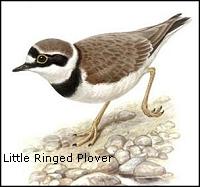 early
Swallow at Toft Hall Farm; the poor thing must have been wondering what it had
done wrong, so few others have returned to join it. I don't think it will have
too much longer to wait though because I counted 15 Swallows over Tatton Mere
this morning with around 30 Sand Martins. Finding the current conditions much
more to their liking, a large flock of Winter Thrushes along Pavement Lane
Mobberley early this morning, c.400 birds, mostly very vocal Fieldfares, but
accompanying them a scattering of Redwings - it's late for such a substantial
aggregation. Just across the fields from where the Thrushes
were feeding, ¼ mile east of the Ilford works on the road between
Knutsford and Wilmslow, lies Mobberley Sand Quarry. Unused since the 1970's
this location built up quite a reputation over a period of some 15 years as a
place where a whole range of species not normally associated with the Cheshire
Plain could be seen, especially Waders during Spring and Autumn passage.
Unfortunately the water table changed and the large area of water that had
formed when quarrying ended receded and dried up entirely during the Summer
months; consequently it became "underwatched" as the number of
species it attracted also fell. Nevertheless at this time of year one or two
birds still drop in and today we watched 2 Little Ringed Plovers feeding on the
waterside mud, they have nested there in the past, and todays birds were still
there at dusk - so watch this space!
early
Swallow at Toft Hall Farm; the poor thing must have been wondering what it had
done wrong, so few others have returned to join it. I don't think it will have
too much longer to wait though because I counted 15 Swallows over Tatton Mere
this morning with around 30 Sand Martins. Finding the current conditions much
more to their liking, a large flock of Winter Thrushes along Pavement Lane
Mobberley early this morning, c.400 birds, mostly very vocal Fieldfares, but
accompanying them a scattering of Redwings - it's late for such a substantial
aggregation. Just across the fields from where the Thrushes
were feeding, ¼ mile east of the Ilford works on the road between
Knutsford and Wilmslow, lies Mobberley Sand Quarry. Unused since the 1970's
this location built up quite a reputation over a period of some 15 years as a
place where a whole range of species not normally associated with the Cheshire
Plain could be seen, especially Waders during Spring and Autumn passage.
Unfortunately the water table changed and the large area of water that had
formed when quarrying ended receded and dried up entirely during the Summer
months; consequently it became "underwatched" as the number of
species it attracted also fell. Nevertheless at this time of year one or two
birds still drop in and today we watched 2 Little Ringed Plovers feeding on the
waterside mud, they have nested there in the past, and todays birds were still
there at dusk - so watch this space!
08/04/03Plenty of Osprey records over the
past few weeks, but none so far from Tatton - a pity because if they are in the
area they may well decide not to proceed further north,
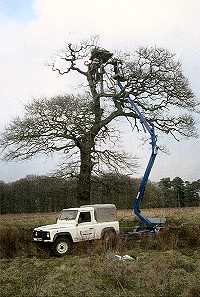 but to
use the impressive facilities provided for them by by the Park Rangers. A
large, robust nest platform has been constructed at the top of a single
isolated oak tree in a quiet, well hidden corner of the Park - it's an
excellent site, the lads have done a brilliant job and we're all hoping that
some time, either this year or some time in the future, the platform will be
used as the species extends its range south from the Scottish Highlands. We
visited Budworth Mere today and found encouraging numbers of Summer migrants,
counting 4 singing Willow Warblers, 10 Chiffchaffs and 6 Blackcaps; this
compares well with the same day last year when we had 6 of all three species.
hirundines are still down in numbers, no House Martins yet and very few
Swallows.
but to
use the impressive facilities provided for them by by the Park Rangers. A
large, robust nest platform has been constructed at the top of a single
isolated oak tree in a quiet, well hidden corner of the Park - it's an
excellent site, the lads have done a brilliant job and we're all hoping that
some time, either this year or some time in the future, the platform will be
used as the species extends its range south from the Scottish Highlands. We
visited Budworth Mere today and found encouraging numbers of Summer migrants,
counting 4 singing Willow Warblers, 10 Chiffchaffs and 6 Blackcaps; this
compares well with the same day last year when we had 6 of all three species.
hirundines are still down in numbers, no House Martins yet and very few
Swallows.
04/04/03 The cold snap in mid-week came and went quickly, but there was a build up of hirundines in the cool, blustery conditions on Wednesday when Derek and Jean noted a flock of 60 - 70 Sand Martins over Tatton Mere. Across at Rostherne at the same time a Black-necked Grebe appeared, no doubt on it's way back to Woolston Eyes where a number of pairs are known to breed. 6 of these delightful birds spent a short time at Tatton this time last year. In excellent light yesterday I watched a phylloscopus Warbler feeding in the lower branches of an oak tree in Dog Wood, it had light brown legs, indicative of a Willow Warbler, but it didn't call let alone sing, so I put it down only as a probable. We didn't have long to wait for the first confirmed Willow Warbler of the year though, because a couple of birders from Higher Poynton had a singing male at the same location less than 24 hours later. I missed this bird but by way of compensation, just as I was leaving the Park this afternoon a Blackcap was pouring out it's song from the depths of a Hawthorn bush, a few yards from the railway bridge on Knutsford Moor!
01/04/03 The long dry spell came to an
abrupt end today as heavy rain and wind swept in from the west, we abandoned
plans for a walk through Tatton in search of the first Willow Warblers or
Blackcaps and instead sought sanctuary in the A.W. Boyd Memorial Observatory at
Rostherne.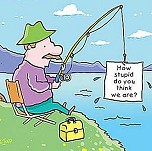 It was a bleak
couple of hours with little of note except for a lone Oystercatcher and around
a dozen Sand Martins, no Swallows have yet appeared in the Observatory log. The
Herons in Tatton have young; last week the adult birds were perched on the rim
of the nest, eventually success was confirmed when two small heads appeared
over the edge!
It was a bleak
couple of hours with little of note except for a lone Oystercatcher and around
a dozen Sand Martins, no Swallows have yet appeared in the Observatory log. The
Herons in Tatton have young; last week the adult birds were perched on the rim
of the nest, eventually success was confirmed when two small heads appeared
over the edge!
26/03/03Many thanks to Dave Clarke, one of Rostherne's long-serving volunteer wardens for this timely update from the Reserve. Still no Sand Martins although one was seen some days ago. The cormorant roost now remains at well over 160 birds, this must be somewhere near Cheshire highest roost. Buzzards and sparrowhawk were seen this morning, Lesser Spotted Woodpecker heard drumming in Wood Bongs remained invisible at all times. A flight of approx 10 Fieldfares sat in the tall trees of Wood Bongs. Common Sandpiper and Green Sandpiper were feeding on the sand bar. Nice to see reported a singleton Hare in Long Pasture, Sunday, at Warburton wet meadows. good numbers of common snipe (30plus) and 5 Jack Snipe flushed from the marshy area. 4 Grey Partridge and 6 Teal. at Moss Brow Farm a splendid count of 25 Yellowhammers in a mixed flock of Tree Sparrow, Chaffinch, Goldfinch and Reed Bunting and 2 more Grey Partridge flew away from us. - DC
23/03/03 The high pressure weather system has been with us now for almost 2 weeks, and shows no sign of moving away. Surprisingly Spring migrants remain quite thin on the ground, especially as the first hirundines arrived back so earlythis year. It wasn't until last Tuesday (18th.) that I came across my first Sand Martins of the year, when 2 birds were noted over Budworth Mere, last year at this time there was a substantial flock of c.150 to 200 Martins over Tatton - there were none there early this morning. Chiffchaffs are about in good numbers, we had 7 singing males at Budworth on Tuesday and 3 in Tatton's Dog Wood today. Over the other side of the mere in Higmere Plantation the lone pair of Herons continue with their incubation, first noted on 20th. February, so if everything has gone according to plan they should hatch out at any moment. News from the Llyn Peninsula this morning, Pete and Liz are at the cottageAGAIN! and report Wheatears, Chiffchaffs, displaying Choughs, Ravens, Rock and Meadow Pipits.
17/03/03 In the Knutsford area we sometimes have to wait until April for the first Swallow of the season. Not so this year, Pete Hall had the first returning bird at Toft Hall Farm this afternoon - 5 days earlier than our previous earliest date (22 March 2000 & 2001).
14/03/03 Super weather at the moment with an anti-cyclone straddling the whole of the country. Cold still nights, followed by blue skies and unbroken sunshine during the day; perfect weather for migration. No further Sand Martin sightings since last Saturday's bird, but the first Chiffchaff of the year was singing in Tatton's Dog Wood this afternoon. Have a look at the BTO Migration Watch pages - having registered you can enter your own sightings, which are saved onto a database, this can be interrogated in a number of different ways. Amongst other things it can show animated maps charting the spread of returning migrants across the country, lists of first and last records plus all your own records - so in theory I suppose it could be used as a personal database onto which you could add all your sightings for later analysis!
9/03/03Yesterday's planned trip to the Derwent
Valley was called off at 9:00am when we met up at the Sessions House, the
weather was just too bad. The main attraction was to have been the displaying
Goshawks,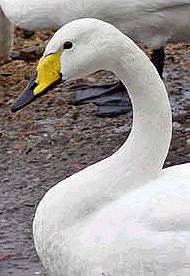 but
with heavy rain and low cloud, a trip over the Pennines would have been a waste
of time. Instead we elected to head north and west up to Martin Mere near
Southport, where there was the promise of some shelter on what was turning into
a really wet day! There were still good numbers of Winter visitors present,
Pink-footed Geese, Greylags and of course Whooper Swans, becoming very vocal as
if in anticipation of their imminent journey north to their Icelandic breeding
grounds. Not everyone had been discouraged by the weather, and a good job to,
because at 10:00 am I received a phone call from Roger Barnes who had just
returned home after a morning in Tatton. At 9:00 am Roger had come across the
year's first Sand Martin as he approached Melchett Mere from the direction of
Tatton Hall, he has confirmed the details in an e-mail.
but
with heavy rain and low cloud, a trip over the Pennines would have been a waste
of time. Instead we elected to head north and west up to Martin Mere near
Southport, where there was the promise of some shelter on what was turning into
a really wet day! There were still good numbers of Winter visitors present,
Pink-footed Geese, Greylags and of course Whooper Swans, becoming very vocal as
if in anticipation of their imminent journey north to their Icelandic breeding
grounds. Not everyone had been discouraged by the weather, and a good job to,
because at 10:00 am I received a phone call from Roger Barnes who had just
returned home after a morning in Tatton. At 9:00 am Roger had come across the
year's first Sand Martin as he approached Melchett Mere from the direction of
Tatton Hall, he has confirmed the details in an e-mail.
Sand Martin Melchett Mere 0900 Sat 8th March. Magical five minutes as the bird circled me flying on one occasion within a few feet of my face and frequently between myself and Henry, my English Springer who was patiently sitting about ten feet from me.
This is the earliest ever record, the 1989 bird also
appeared on the 8th, but not until late afternoon. Well done again Roger! I
think this is the third time he has had the first bird if the year - work
probably gets in the way of too much birding but when he does go out he doesn't
mess about - remember the Tropic Bird!!
So let's have a look at the entries for the 2003 Sand Martin Competition - 3 people predicted
the correct day, of these Karl Johnson from Preston was the closest with his
time of 09:15 - so congratulations to Karl and commiserations to Nigel Smalley
and our own Jane Crossen who came so close this year!
04/03/03 Over the past 10 years we've become used to seeing Buzzards almost every day in this part of the County, but there are still some areas where they're not seen.
Buzzards seem to do really well in Cheshire these days. Heading west along the M56 on Saturday morning on a shopping trip to Chester, I counted no fewer than three on the brief stretch between junctions 8 and 9. When we arrived half an hour later in Upton there were two more in the air together. Regular in good numbers in the west of the county, they are also becoming fairly easy to find in the north east, especially around the sand quarries in the Chelford area. Regrettably they don't seem to have made it into Stockport airspace just yet. Here we have only Kestrel and Sparrowhawk as regular diurnal raptors. The former seem a little more scarce than they were ten years ago, while the latter have come back from leaner years with a vengeance. I would guess that at least half a dozen different Sparrowhawks have been based within a mile of my home this winter. As impressive as they are, I had distinctly mixed feelings about them when my wife described the demise of my regular garden Song Thrush a couple of weeks ago at the talons of a male. Oddly enough heading into the metropolis adds another species to the list of possibles. From my office window in central Manchester I now see Peregrine Falcons quite regularly. They were believed to be nesting on Sunley Tower a couple of years ago, though I see them in the area of Portland Tower. It may seem an odd home for a bird normally associated with wild, windswept cliff tops, but the concrete towers and ready supply of feral pigeons are an obvious artificial attraction. Perhaps they have been given a grant by the city council's pest control department! - Nigel Troup
03/03/03
 |
Happy Birthday - John Somerville - 60 today! |
28/02/03 Having spent 20 years as volunteer wardens with
the RSPB at Loch Garten in Speyside, one of the things we learnt was that
Ospreys are predictable and become set in their ways.
 Surrounding the nest site are
numerous perches on which they could spend their time feeding or lounging
around in between periods of activity escorting intruding Crows or unmated
Ospreys from the premises, but they only used one or two favourite trees. It
was the same with the nest tree itself - even when completely new birds
appeared in the Spring they chose the same one - which was (and still is)
fortunate of course because the now large and sophisticated visitor centre
would become a bit of a "white elephant" if there were no birds to
view "in the wild" through the viewing slots. On a much smaller scale
a bench at Tatton Park, on the track from the Old Hall to the Mill Pond, sports
a brass Plaque engraved "Osprey Bench", because whenever Ospreys
appears in the park and stay around for a few days they always use the same
tree to roost and feed, and it's from the "Osprey Bench" that the
best views can be obtained! Now - like other raptors Ospreys are doing rather
nicely and are even nesting in England, in counties to the north and the south
of Cheshire, so why not here too, after all in 1998 one bird spent most of the
Summer in Tatton. I was delighted to learn from Darren
Morris, one of the park rangers, that this Spring they are planning to erect an
Osprey nesting platform, like the ones being used at Rutland Water in an
attempt to encourage a pair to actually breed here - what a splendid idea!
Surrounding the nest site are
numerous perches on which they could spend their time feeding or lounging
around in between periods of activity escorting intruding Crows or unmated
Ospreys from the premises, but they only used one or two favourite trees. It
was the same with the nest tree itself - even when completely new birds
appeared in the Spring they chose the same one - which was (and still is)
fortunate of course because the now large and sophisticated visitor centre
would become a bit of a "white elephant" if there were no birds to
view "in the wild" through the viewing slots. On a much smaller scale
a bench at Tatton Park, on the track from the Old Hall to the Mill Pond, sports
a brass Plaque engraved "Osprey Bench", because whenever Ospreys
appears in the park and stay around for a few days they always use the same
tree to roost and feed, and it's from the "Osprey Bench" that the
best views can be obtained! Now - like other raptors Ospreys are doing rather
nicely and are even nesting in England, in counties to the north and the south
of Cheshire, so why not here too, after all in 1998 one bird spent most of the
Summer in Tatton. I was delighted to learn from Darren
Morris, one of the park rangers, that this Spring they are planning to erect an
Osprey nesting platform, like the ones being used at Rutland Water in an
attempt to encourage a pair to actually breed here - what a splendid idea!
23/02/03 As the temperature reached the low teens sure signs today that, at last, Spring is just around the corner. In Mobberley along Pavement Lane, looking across to the south in the direction of Booths Mere, the first returning Lapwings, 5 birds on and over the large fields of Winter wheat, tumbling chases through the air, sorting out partners and territories for the coming season, accompanied all the time by those truly evocative calls that we look forward to hearing so much at this time of the year. Also back, one or two Skylarks, hanging almost invisible in the sky, high over the Fox Harbour area of the village. The species has declined in numbers over the past few years, but it's still widespread during the Summer months, although not resident all the year round as there's little in the way of suitable food to sustain large numbers during the Winter. It may well be that our birds don't stray too far during the cold weather as, only about 7 miles from where today's birds were singing, we happened across a massive flock of Skylarks last Tuesday as we crossed a huge stubble field on Carrington Moss on the outskirts of Altrincham. There were 100's of birds wintering on this single field, so difficult to estimate numbers - they went up as we approached, flew over our heads and immediately settled back down a few yards behind us. The whole flock was never in the air at the same time but there were certainly 1000+. Also taking advantage, a finch flock, commuting nervously between the ground and a tall Hawthorn hedge on the edge of the field, almost exclusively Chaffinches with a scattering of Bramblings; not as numerous as the larks but a substantial flock - probably around 500 birds.
15/02/03 Work is to begin soon on the reclamation work at Northwich's Neumann's and Ashton's Flashes, and because the Health and Safety Executive class it as a construction site the whole area will be closed off for up to 18 months while the work is carried out. We visited Neumann's last week on our way back from a walk round the Anderton Reserve - it was full of Lapwings, there must have been well over 1,000 - it's difficult to believe that the population has declined so much in recent years when flocks of this size still occur. Accompanying the Lapwings were around 20 Golden Plovers, whilst on the water itself were Mallard, Teal, Wigeon, Gadwall, Shoveler and a pair of displaying Goldeneye; this is an excellent location and the proposed improvements and the provision of new hides will turn it into one of the areas premier Reserves. It's a pity the RSPB don't spend a little more money in this part of the World rather than purchasing yet another zillion acres of inaccessible Scottish bogland!
10/02/03 A little early morning snow to greet us last Wednesday (5th) when we set off on our final outing to Marthall for the BTO Winter Farmland Bird Survey, we found the going easier than on our last visit as most of the lying water had frozen over during the past few nights so we were able to concentrate more on the birds and less on the conditions underfoot. More Winter Thrushes on this occasion, the first field we came to contained good numbers of both Redwing and Fieldfare plus a bit of a bonus in the form of 2 Common Snipe that dropped in unexpectedly amongst the Thrushes. The snow passed over quickly and the clouds vanished leaving a beautiful sunny day and it became relatively warm as the morning progressed, this encouraged a couple of Chaffinches to splutter into song and as we reached the end of our allotted 4 hours they'd found their full voices and prompted more and more of their neighbours into action - a sort of vocal "domino effect" so that eventually the whole area was echoing to the sound of singing birds! Yesterday we made our way once again over the Pennines to Derbyshire on our February field trip to two new venues, Cromford and the Ogston Reservoir. We started south of Matlock in the picturesque village of Cromford and spent a pleasant couple of hours searching for the Hawfinches that had been reported earlier in the morning at a favoured location. Only one member of the party was lucky enough to catch a glimpse of this most elusive of finches when two birds flew overhead as we stood near the Church, close to the river where we all had excellent views of a feeding Dipper. A short drive north found us at the Ogston Reservoir where we lunched overlooking the south end of the lake, which was being kept clear of wildfowl by the activities of the local yacht club whose members were generating a disproportionate amount of noise considering there were only 2 vessels racing! Willow Tits were calling from bushes near the car park, whilst on the water to the north and center, away from the Yacht Club we noted Little and Great Crested Grebes, 1 imm male Goosander, 200+ Canada Geese, Wigeon, Teal, Mallard, Tufted Duck and 200+ Pochard - rather like Tatton in the 1970's. There is a well-built and capacious Public hide that is free to enter plus a number of private hides restricted to Bird Club members only - at only £5 pa excellent value if you live locally - the hide we saw, just up from the public hide, was particularly well situated on the waters edge overlooking a spit that no doubt attracts some good birds during passage periods! Looking at the Club's website it's apparent that a lot of effort has gone into providing these facilities and those involved are to be congratulated.
03/02/03 A bit of real Winter weather for Cheshire today as strong north-westerlies brought in a mixture of hail, sleet and snow sweeping in over Tatton Mere, the mid-morning temperature reached no higher than 3ºC. Across from Dog Wood in Higmere Plantation the single pair of Herons have returned again for another breeding attempt, last year of course they failed and the nest was eventually taken over by a pair of Canada Geese who were also unsuccessful, they did lay eggs and began incubation 40' up in the air, but no young appeared. A certain amount of house-keeping was going on as the female bird rearranged the remains of last years nest, she was joined by the male bird who brought in a small twig which was offered, accepted and placed carefully in place. On the Mere itself there was little of interest, just a few Black-headed Gulls, Great Crested Grebes, Tufties and a couple of Goldeneye, although the greyness of the day was interrupted for a split second as two Kingfishers shot through my field of view, twisting and turning low over the surface and across the reeds towards Knutsford Moor. Again few Winter passerines, no Redwings or Fieldfares, just a single female Siskin plus an overflying Redpoll, I thought that the heavy snowfalls in the east of England during the last week would have forced substantial numbers over the Pennines; but this has not proved to be the case.
27/01/03 More Winter
news from our Stockport correspondent, Nigel Troup, who also made his way
across to Knutsford at the weekend and had 14 Mandarin Ducks (8 males) at the
southern end of the main mere.
The area to the south east of Stockport, where I live, is no birding hotspot,
but we do get our fair share of winter finches. Siskins are never hard to find,
especially at Happy Valley along the Ladybrook river, and in the pondside trees
at Bramhall Park. I found several small parties on Saturday afternoon on the
old Mirrlees golf course in Woodsmoor, feeding noisily in alder and larch with
their larger cousins, the Goldfinch. This site also has resident Bullfinches,
and two handsome males were in the trees by the anglers' pool. In some winters
the Lesser Redpolls outnumber Siskins here. The small scattered flocks
eventually combining by March to form much larger groups. But 2003 hasn't been
a redpoll year: I have seen only an isolated individual since the new year.
This year's bonus, though, has been a healthy local flock of Brambling. One of
the bird information services carried a report of 200+ of these Scandinavian
visitors feeding on beech mast in nearby Woodbank Park last week. I found half
a dozen near Offerton School in early January, and was delighted to stumble
upon a further 20 or so on Saturday morning, while watching my son play
football in Torkington Park, Hazel Grove. They slightly outnumbered the
Chaffinch in a small mixed flock. There have been other winter visitors nearby.
A friend of mine, who has decided to develop a local patch, stumbled on two
Waxwings on Saturday 18th on only his second visit. The site is an area of
rough ground, just off the A34 bypass between Cheadle Royal and Stanley Green.
I joined him briefly in the afternoon, when we couldn't relocate the birds. A
couple of Reed Buntings and a male Stonechat were ample compensation. As a
deviation from the wintry theme, I found a male Blackcap in neighbouring
gardens over the weekend. These make only rare appearances here in the winter,
but by early May half a dozen or so males will be singing lustily from the
nearby bushes. - NT
24/01/03 Wellingtons were the order of the day on
Wednesday for our second trip (of three) out to Marthall for the
BTO Winter
Farmland Bird Survey. The 1 square kilometer we cover contains a number of
roads, but most of the route is across fields of Autumn sown Winter wheat plus
stubble from last years maize crop, needless to say, after all the recent rain,
the going was rather sticky in places!
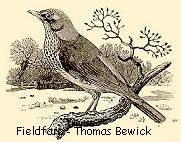 The
only species feeding on the stubble were Wood Pigeons, a great clattering of
wings as they took to the air as we approached, their close cousins the
Collared Doves had other things on their minds and we noticed much display
throughout the morning. Also active were the local Jackdaws, whilst
intermittent song came from Wrens, Dunnocks, Great Tits and a lone Mistle
Thrush. A small flock of 8 Tree Sparrows in one of the boundary hedges livened
up the recording forms, but we were had only one flock of finches; around 50
Chaffinches in one of the farmyards and not a single bunting in the 4 hours
allowed for the survey. Conspicuous by their absence were Winter Thrushes,
normally we have large flocks throughout the day confusing the count by flying
from one field to the next, but today it was 3 hours before the first were
recorded as a mixed flock of Redwings and Fieldfares appeared - around 120
birds. None at all the previous day in Tatton, it was very quiet all morning,
not a single Siskin seen as we walked from Knutsford Moor to Melchett Mere and
back. On the main mere 2 male Goldeneyes were displaying to a single female
whilst in the tangle of roots where the trees of Higmere Plantation (opposite
Dog Wood) meet the water we counted 9 Mandarin Ducks - surprisingly difficult
to see despite the spectacular plumage of the male birds.
The
only species feeding on the stubble were Wood Pigeons, a great clattering of
wings as they took to the air as we approached, their close cousins the
Collared Doves had other things on their minds and we noticed much display
throughout the morning. Also active were the local Jackdaws, whilst
intermittent song came from Wrens, Dunnocks, Great Tits and a lone Mistle
Thrush. A small flock of 8 Tree Sparrows in one of the boundary hedges livened
up the recording forms, but we were had only one flock of finches; around 50
Chaffinches in one of the farmyards and not a single bunting in the 4 hours
allowed for the survey. Conspicuous by their absence were Winter Thrushes,
normally we have large flocks throughout the day confusing the count by flying
from one field to the next, but today it was 3 hours before the first were
recorded as a mixed flock of Redwings and Fieldfares appeared - around 120
birds. None at all the previous day in Tatton, it was very quiet all morning,
not a single Siskin seen as we walked from Knutsford Moor to Melchett Mere and
back. On the main mere 2 male Goldeneyes were displaying to a single female
whilst in the tangle of roots where the trees of Higmere Plantation (opposite
Dog Wood) meet the water we counted 9 Mandarin Ducks - surprisingly difficult
to see despite the spectacular plumage of the male birds.
18/01/03 Despite his family commitments Nigel Troup managed to fit in a little birding over the holiday period, mainly around the Stockport area.
I have had some high points on my local patches
over the Christmas period, with Lesser Spotted Woodpecker on Mirrlees fields,
Woodsmoor on New Year's Eve (eye level views from just a few feet of a male in
young oaks), as well as Reed Bunting just minutes later (another patch lifer).
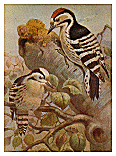 Although condemned to become
housing and airport overspill car parking, Adswood Tip managed to yield a Jack
Snipe on successive days over the new year. I have also seen Kingfisher around
Bramhall Park / Happy Valley once or twice recently, and redwing and Bullfinch
in my garden.
Although condemned to become
housing and airport overspill car parking, Adswood Tip managed to yield a Jack
Snipe on successive days over the new year. I have also seen Kingfisher around
Bramhall Park / Happy Valley once or twice recently, and redwing and Bullfinch
in my garden.
A regular route along Poise Brook, Offerton onto the few shreds of remaining
farmland on the opposite side of the Goyt brought Dipper (on Poise Brook),
Goosander (a group of 11, including seven males, on the Goyt), Little Owl, and
half a dozen Brambling. My previous visit also produced a couple of
Yellowhammer - an everyday occurrence on your patch, but now quite noteworthy
in the Stockport area.
On Saturday I visited a site alongside Sinderland Brook near Broadheath,
Altrincham that currently hosts a healthy wintering flock of buntings,
including the increasingly elusive Corn Bunting. The bad, though familiar, news
is that development has been threatened here too. (NT)
The Woodpecker must have been nice Nigel, the birds at Marbury have been active recently with some drumming heard and here in Mobberley Len Mason had a "lesserpecker" in Bucklow Avenue on 22nd December.
14/01/03 Our first visit to the
Old Moor Wetland
Center near Barnsley was in November 2001, at the time we thought a visit
later on in the Winter would be very rewarding and this proved to be the case
on Saturday when we made our way across the Pennines to South Yorkshire. A
video link from the nearby feeding station carried pictures to a monitor
located in the information center, huge numbers of birds could be seen taking
full advantage, we noted Greenfinches, Goldfinches, Yellowhammers, House and
Tree Sparrows. The latter have been actively encouraged for a number of years
on this reserve by winter feeding and the provision of 200 nest boxes, it's
been
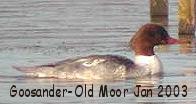 a successful
exercise, there are currently more than 200 Tree Sparrows on the reserve,
including 40 unringed birds (all the nestlings from the nest boxes are ringed).
Moving outside Redwings and Fieldfares could be seen in the bushes round the
feeding station, whilst in a tree above we had good views of a roosting Little
Owl, quite unperturbed with the activity below. More owls at the far end of the
reserve, this time Long-eared - 4 birds roosting together in Hawthorn bushes a
short distance from the last hide, a combination of bright afternoon sunshine
and powerful optics gave everyone a chance to examine the birds in great
detail. Species seen on the edges of the pools included Snipe, Redshank,
Lapwings and Golden Plover, up to 3000 plovers have been counted this Winter.
On the pools themselves, in perfect viewing conditions, we had Wigeon, Ruddy
Duck, Coot, Mallard, Teal, Pintail, Tufted Duck, Pochard, Gadwall, Shoveler and
no less than 33 Goosanders in beautiful plumage - a fine sight!
a successful
exercise, there are currently more than 200 Tree Sparrows on the reserve,
including 40 unringed birds (all the nestlings from the nest boxes are ringed).
Moving outside Redwings and Fieldfares could be seen in the bushes round the
feeding station, whilst in a tree above we had good views of a roosting Little
Owl, quite unperturbed with the activity below. More owls at the far end of the
reserve, this time Long-eared - 4 birds roosting together in Hawthorn bushes a
short distance from the last hide, a combination of bright afternoon sunshine
and powerful optics gave everyone a chance to examine the birds in great
detail. Species seen on the edges of the pools included Snipe, Redshank,
Lapwings and Golden Plover, up to 3000 plovers have been counted this Winter.
On the pools themselves, in perfect viewing conditions, we had Wigeon, Ruddy
Duck, Coot, Mallard, Teal, Pintail, Tufted Duck, Pochard, Gadwall, Shoveler and
no less than 33 Goosanders in beautiful plumage - a fine sight!
My thanks go to John Somerville for keeping the site up to date during our
holiday in New Zealand and encouraging so many people to send in records and
articles, I would love this to continue, any contributions can be sent via
e-mail to tony@10X50.com. I enjoyed reading
about the avian comings and goings in frost-bound Cheshire from the comfort of
an air conditioned cyber cafe thousands of miles away - isn't technology
wonderful? I almost felt homesick!
The trip to New Zealand was a great success we stayed with my wife's Sister
Katherine and her husband John - although it was a family holiday John and I
were granted a couple of full-day passouts! and took the opportunity to visit
the reserves at
Miranda
and Tiritiri Matangi. At
Miranda we had good views of New Zealand Dotterel, Red-necked Stint and the
only bird I promised myself on the trip - Wrybill, whilst over on Tiritiri a
whole host of endemic species are prospering on an island cleared of introduced
predators and re-planted with 300.000 native trees and bushes.
On the return journey we stopped overnight in Los Angeles and before we left
the following day I had the opportunity to spend an hour birding from the beach
at Santa Monica - yes that's the one "muscle Beach" - I felt quite at
home as you can imagine! No American bird book of course but I did write up a
number of descriptions and appeared to have seen Marbled Godwit, Willet and
Heerman's Gull amongst others. It's quite whetted my appetite!
 8/1/03 Recent sightings by Dave Clarke.5th January, Warburton Wet
Meadows, 20+ Snipe, Stonechat, Reed Buntings, 12 Grey Partridge. 8th
January, Rostherne Mere, Bittern, 2 Scaup (female & immature), 8
Redpoll, 3 female Sparrowhawks.
8/1/03 Recent sightings by Dave Clarke.5th January, Warburton Wet
Meadows, 20+ Snipe, Stonechat, Reed Buntings, 12 Grey Partridge. 8th
January, Rostherne Mere, Bittern, 2 Scaup (female & immature), 8
Redpoll, 3 female Sparrowhawks.
7/1/03 A good morning at Marbury Country Park by Sheila and Derek with 1 x Bittern, 2 x Lesser Spotted Woodpeckers, and a Green Woodpecker, all seen from the hide looking across the mere to the Coward Memorial reed beds. A later walk through the woods then produced a Great Spotted Woodpecker and large flocks of Long Tailed Tits accompanied by numerous Nuthatch calls.
2/1/03 Bob Groom spotted a Red Kite in the Tatton Park deer enclosure. His other sightings in the park included 1 Buzzard, 22 Fieldfares, 2 Redwings, 1 Green Woodpecker, 1 Great Spotted woodpecker, 1 Grey Wagtail, 200 Lapwing over the park farmland and 2 Brambling in Dog Wood. Who will be the first in 2003 to spot a Lesser Spotted Woodpecker in the park?

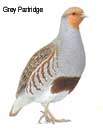 1/1/03 Jill Thornley reported 19
Red-Legged Partridge in the front garden of her house at Stretton. Ten years
ago only Grey Partridge would have been seen in the garden but now Jill only
sees Grey Partridge on the fields across the road from her house. Her morning
bird count of 20 species did not include either House Sparrow or Tree
Sparrow.
1/1/03 Jill Thornley reported 19
Red-Legged Partridge in the front garden of her house at Stretton. Ten years
ago only Grey Partridge would have been seen in the garden but now Jill only
sees Grey Partridge on the fields across the road from her house. Her morning
bird count of 20 species did not include either House Sparrow or Tree
Sparrow.